

You are using an out of date browser. It may not display this or other websites correctly.
You should upgrade or use an alternative browser.
You should upgrade or use an alternative browser.
Daver
PMA Member
What is the latest you would suggest hinge cutting. Is it ok do cut in the spring or summer? Or a winter only operation.
I know some who have done it in the fall and everything seemed to be fine for them. I personally would not be interested in doing it in the summer because of the poison ivy, heat and ticks/chiggers...but other than that, it should be fine too.
dbltree
Super Moderator
I have a ton of ironwood
That's odd because all the ironwood that I hinge, usually always stays hinged? As mentioned either way is fine but get it cut because it is shade tolerant and will grow under a canopy creating in effect a double canopy and zero undergrowth.
What is the latest you would suggest hinge cutting. Is it ok do cut in the spring or summer? Or a winter only operation.
It can be done almost anytime but oak wilt is a concern during spring and summer so any cutting is discouraged during that time. Late winter/early spring and again when they go dormant in the fall is optimum time to hinge.
You must not have chiggars or you wouldn't even consider summer timber work...
Crimson Arrows
Well-Known Member
It is amazing how they can still not tip with less than one inch attached to the tree.
We have noticed this too as my farm is in the running for the Natioanl Ironwood of the Year Award
A little "push" and they go right down...like most bullies :thrwrck:
And most stay hinged, so far anyway
singlecoyote
Proud member of the IBA
I wouldn't hinge ironwood. You will be better off in 5 years if you cut it and kill it with chemical. Hope for or plant something beneficial (basically anything but ironwood)to create the undergrowth that you want. If you hinge it you will end up with an ironwood "bush", which may be good cover as it holds its leaves long but still competes with everything that is trying to grow in the area. I'd kill it and seed some shrubs and/or plant some cedars. You will have cover via the downed tops until the shrubs and natural succesion take off.
dbltree
Super Moderator
I wouldn't hinge ironwood. You will be better off in 5 years if you cut it and kill it with chemical. Hope for or plant something beneficial (basically anything but ironwood)to create the undergrowth that you want. If you hinge it you will end up with an ironwood "bush", which may be good cover as it holds its leaves long but still competes with everything that is trying to grow in the area. I'd kill it and seed some shrubs and/or plant some cedars. You will have cover via the downed tops until the shrubs and natural succession take off.
It depends on the timber...in some cases you are correct but not all so get your foresters input...not on hinging but if you need to kill it or not. Each forester may have a different opinion too but if the oaks there are 10-20 years from harvest and the stand is pretty dominate in oaks there may not be any oak regeneration anyway, until there is a harvest.
In all the situations where I have hinged trees, including ironwood (where there are oak seed trees) the oak seedlings quickly rose above the hinged trees. Ironwood is shade tolerant but doesn't compete well once the canopy has been removed..not always a right or wrong but a case by case judgement call....
singlecoyote
Proud member of the IBA
I respectfully disagree. I would not reccomend to anyone in any situation to hinge ironwood.
If you are spending the time to go in and hinge it, take the extra few seconds and cut it all the way through and squirt it with tordon.
Your end result will make a better timber for your pocket book and the deer.
Hinge away with the other undesireables, but kill the ironwood.
If you are spending the time to go in and hinge it, take the extra few seconds and cut it all the way through and squirt it with tordon.
Your end result will make a better timber for your pocket book and the deer.
Hinge away with the other undesireables, but kill the ironwood.
In a few areas, we have a ton of ironwood, unfortunately, I have a lot of exposed rock on the property and am not sure how well the understory will grow if I end up cutting these trees rather than hinging them. The other predominant species is red maple, ash and some cherry and oak. Would it be better to have maple than ironwood? I can't plant a lot because of the rock. I am hoping that the two ponds we are putting in are going to help with keeping more deer in our existing cover
dbltree
Super Moderator
Would it be better to have maple than ironwood?
Both are pretty shade tolerant but maple would no doubt be better then ironwood. Have you considered planted some oaks and tubing them amongst the downed trees?
Yes, I have considered planting oaks. With a new baby it is going to tough to do this, I was planning on doing some direct seeding with the acorns from my red oaks next year. There was really no crop of acorns last year, but they should do well this once I trim the trees around the oaks.
Maple versus Iron Wood
I've seen similiar reports to the one below, with Hard Maple having timber value that is considerably more than some Oak and Soft Maple (see below).
http://www.dec.ny.gov/docs/lands_forests_pdf/spr2011winter.pdf
Some Maple is actually considered preferred browse too.
http://www.michigan.gov/dnr/0,4570,7-153-10370_12148-61306--,00.html
So Iron Wood aside you probably want to figure out what kind of Maple you have to see if it's worth managing it from a timber value perspective too.
I've seen similiar reports to the one below, with Hard Maple having timber value that is considerably more than some Oak and Soft Maple (see below).
http://www.dec.ny.gov/docs/lands_forests_pdf/spr2011winter.pdf
Some Maple is actually considered preferred browse too.
http://www.michigan.gov/dnr/0,4570,7-153-10370_12148-61306--,00.html
So Iron Wood aside you probably want to figure out what kind of Maple you have to see if it's worth managing it from a timber value perspective too.
dbltree
Super Moderator
Ironwood Management
A good question was brought up regarding "ironwood"...should it be hinged, should we cut and treat it or simply leave it alone?
Ironwood; eastern hop-hornbeam Ostrya virginiana
My purpose here is helping people improve their habitat for whitetails with emphasis on holding mature whitetail bucks on their property so I try to use caution to always provide facts and supporting data rather then "opinion". I have decades of experience and work with landowners across SE Iowa where I have physically done timber stand improvement and been able to observe the results. I do all of that following the advice of a number of very experience foresters, all with varying thoughts on timber management and then combine that with whitetail management goals that also varies among landowners. I share that because it is important to know the information I post is trustworthy and backed up by facts and actual experience on more then just a few acres.
Landowners may have very different goals so it is my goal to give good information that allows the landowner to make good habitat choices that are right for them. If the primary goal is holding mature whitetails then habitat improvements may be very different then if the landowner prefers to manage solely for timber and agricultural interests so it is important on a forum to remember that your goals may not be the same as those of others.
Ironwood is a shade tolerant tree that can grow quite comfortably under the canopy of large trees such as oak and hickory. I took these pictures today while doing TSI today...
I fairly large ironwood tree
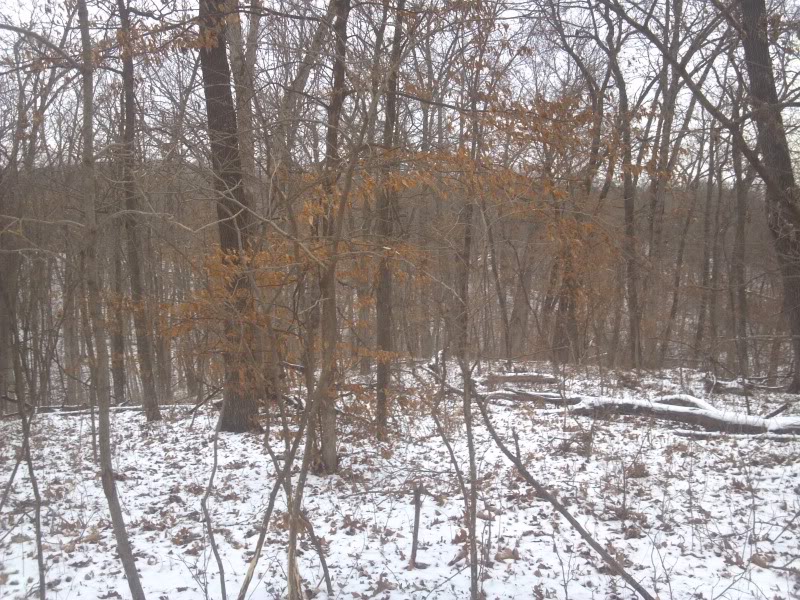
under the canopy of very large and nearly mature oaks
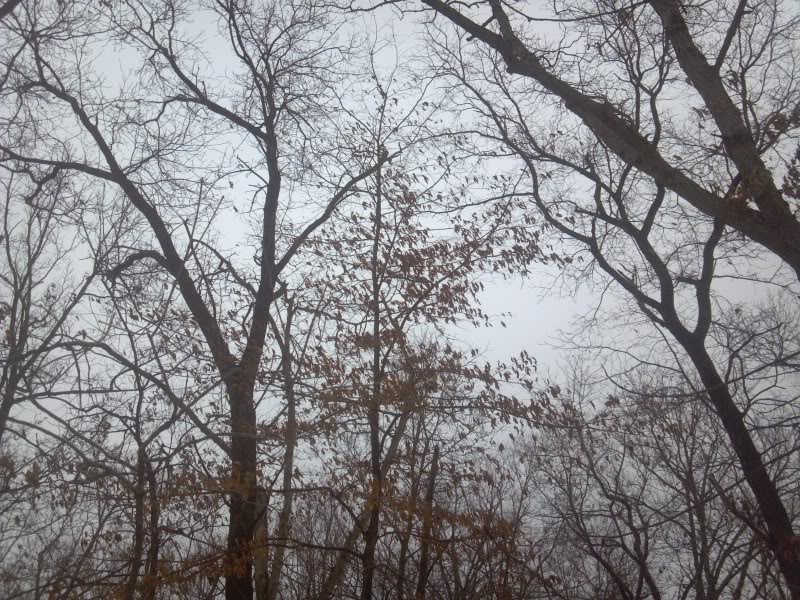
Because ironwood trees are shade tolerant they can inhibit oak regeneration and hence are considered a "weed tree" but the key here is understanding "oak regeneration" and when that actually occurs? Typically oak regeneration is often greatest right after a harvest when the canopy is removed and there is soil disturbance and it is at that time when competitive weed trees such as ironwood are often cut and treated with herbicide.
Generally a timber harvest is followed by timber stand improvement to kill weed or cull trees and allow the remaining unharvested trees to grow and it is at that point we might cut and kill ironwood. I did this very thing on one TSI job last winter, we hinged the ironwood to give us more ground cover but treated probably 80% of the hinged ironwood with Tordon RTU
Oak Regeneration
This spring we will interplant red cedars among the open areas to increase bedding opportunities and because of the harvest the year before there is already plenty of oak regeneration.
That then is an example of when killing the ironwood might be the best option so when might we just hinge it and allow it to re-grow? When the oak timber is relatively mature such as shown here...there will not be any oak regeneration or at best it will be minimal.
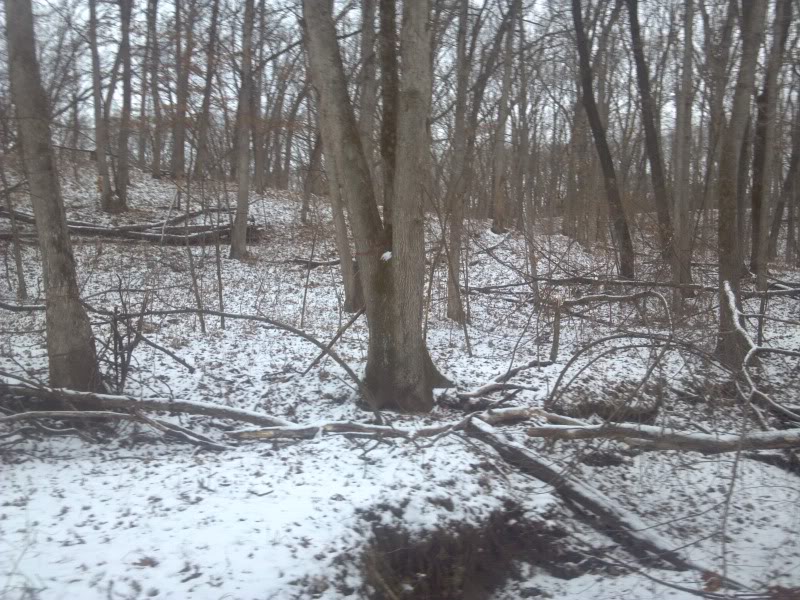
The canopy from the large existing oaks is as bad or worse then the ironwood and there will be almost no regeneration, so in this case there is simply no valid reason to kill the ironwood.
The assumption here is that most people reading this thread are interested in holding mature whitetail bucks on their property and to do that we need thick, dense understory...BRUSH! In large mature timber that is next to impossible but we take advantage of every opportunity to create any ground cover at all and in this case ironwood may be one of the only viable options.
Many foresters may see it this way...the only good ironwood is a dead one, but from our standpoint of whitetail habitat it can serve a purpose until such time that you may be ready to do a harvest.
So what happens when we do radical hinging/cutting and severely open up canopy?
This is what happens most frequently in SE Iowa....oaks leap to life and quickly dominate
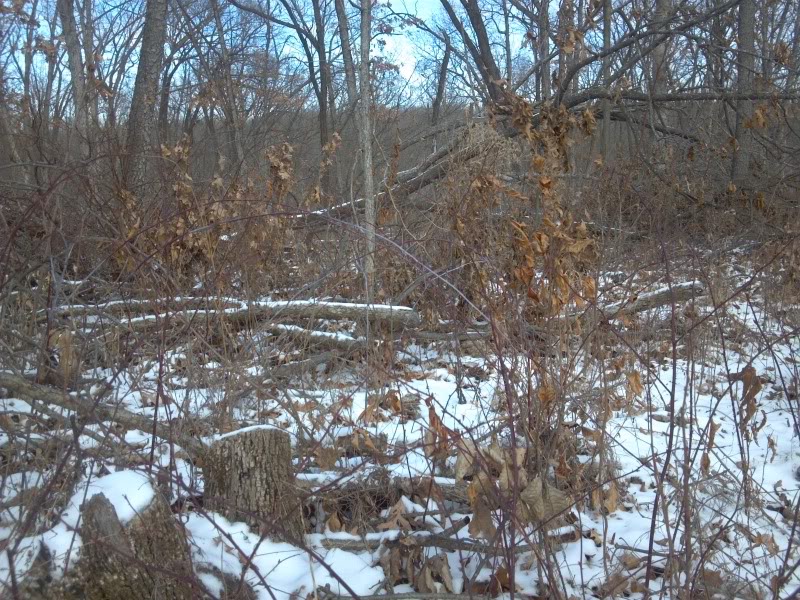
Large trees were felled and broke off the hinged trees in these pics but in open sunlight the oaks quickly out grew the ironwood in part because the ironwood thrives best in shade rather then open full sun.
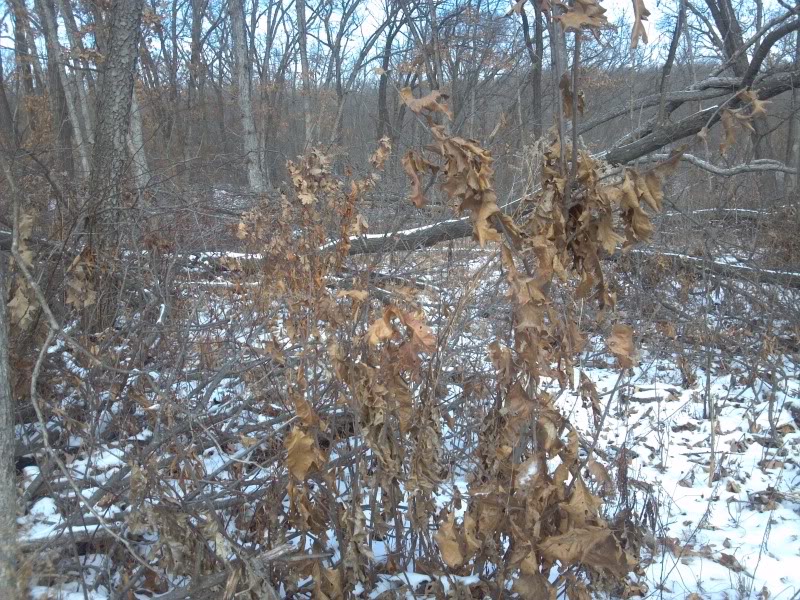
The lack of canopy allows young oaks to grow rapidly along with blackberry brambles and other sun loving forbs and plants.
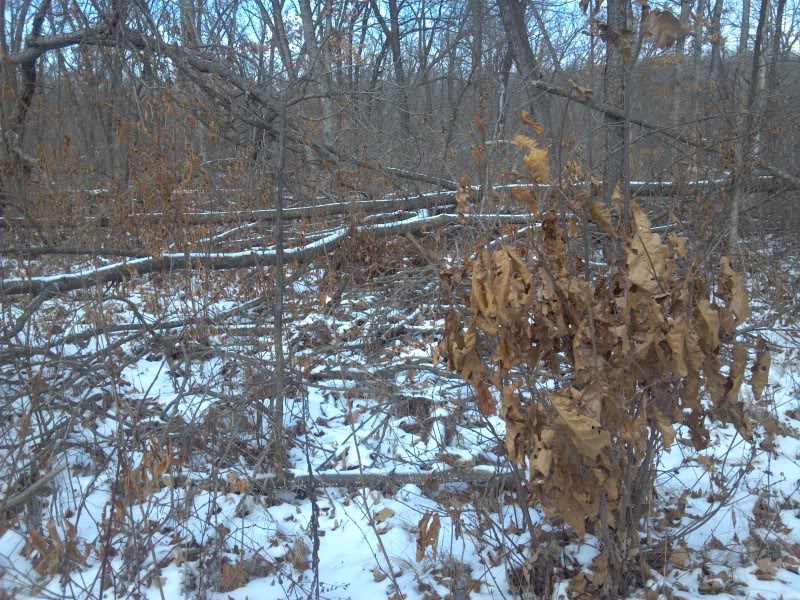
In smaller woodlots you have the option of micro managing small areas where some weed trees are chemically treated and oaks planted and tubed in those areas, while other areas are allowed to become thicker cover.
Hinging itself is not for everyone, regardless of species and each landowners habitat and whitetail management goals may vary widely but based on the facts you can make decisions that will be right for you. There is no across the board right/wrong way to manage your timber or habitat in general...you have options...choose the ones that will work best to meet your goals....
A good question was brought up regarding "ironwood"...should it be hinged, should we cut and treat it or simply leave it alone?
Ironwood; eastern hop-hornbeam Ostrya virginiana
My purpose here is helping people improve their habitat for whitetails with emphasis on holding mature whitetail bucks on their property so I try to use caution to always provide facts and supporting data rather then "opinion". I have decades of experience and work with landowners across SE Iowa where I have physically done timber stand improvement and been able to observe the results. I do all of that following the advice of a number of very experience foresters, all with varying thoughts on timber management and then combine that with whitetail management goals that also varies among landowners. I share that because it is important to know the information I post is trustworthy and backed up by facts and actual experience on more then just a few acres.
Landowners may have very different goals so it is my goal to give good information that allows the landowner to make good habitat choices that are right for them. If the primary goal is holding mature whitetails then habitat improvements may be very different then if the landowner prefers to manage solely for timber and agricultural interests so it is important on a forum to remember that your goals may not be the same as those of others.
Ironwood is a shade tolerant tree that can grow quite comfortably under the canopy of large trees such as oak and hickory. I took these pictures today while doing TSI today...
I fairly large ironwood tree

under the canopy of very large and nearly mature oaks

Because ironwood trees are shade tolerant they can inhibit oak regeneration and hence are considered a "weed tree" but the key here is understanding "oak regeneration" and when that actually occurs? Typically oak regeneration is often greatest right after a harvest when the canopy is removed and there is soil disturbance and it is at that time when competitive weed trees such as ironwood are often cut and treated with herbicide.
Generally a timber harvest is followed by timber stand improvement to kill weed or cull trees and allow the remaining unharvested trees to grow and it is at that point we might cut and kill ironwood. I did this very thing on one TSI job last winter, we hinged the ironwood to give us more ground cover but treated probably 80% of the hinged ironwood with Tordon RTU
Oak Regeneration
This spring we will interplant red cedars among the open areas to increase bedding opportunities and because of the harvest the year before there is already plenty of oak regeneration.
That then is an example of when killing the ironwood might be the best option so when might we just hinge it and allow it to re-grow? When the oak timber is relatively mature such as shown here...there will not be any oak regeneration or at best it will be minimal.

The canopy from the large existing oaks is as bad or worse then the ironwood and there will be almost no regeneration, so in this case there is simply no valid reason to kill the ironwood.
The assumption here is that most people reading this thread are interested in holding mature whitetail bucks on their property and to do that we need thick, dense understory...BRUSH! In large mature timber that is next to impossible but we take advantage of every opportunity to create any ground cover at all and in this case ironwood may be one of the only viable options.
Many foresters may see it this way...the only good ironwood is a dead one, but from our standpoint of whitetail habitat it can serve a purpose until such time that you may be ready to do a harvest.
So what happens when we do radical hinging/cutting and severely open up canopy?
This is what happens most frequently in SE Iowa....oaks leap to life and quickly dominate

Large trees were felled and broke off the hinged trees in these pics but in open sunlight the oaks quickly out grew the ironwood in part because the ironwood thrives best in shade rather then open full sun.

The lack of canopy allows young oaks to grow rapidly along with blackberry brambles and other sun loving forbs and plants.

In smaller woodlots you have the option of micro managing small areas where some weed trees are chemically treated and oaks planted and tubed in those areas, while other areas are allowed to become thicker cover.
Hinging itself is not for everyone, regardless of species and each landowners habitat and whitetail management goals may vary widely but based on the facts you can make decisions that will be right for you. There is no across the board right/wrong way to manage your timber or habitat in general...you have options...choose the ones that will work best to meet your goals....
Last edited:
IQDM
New Member
This spring we will interplant red cedars among the open areas to increase bedding opportunities and because of the harvest the year before there is already plenty of oak regeneration.
Paul, What are you thoughts on those Red Cedars planted in these ares? I have a project that we are working on that is very similar to yours... We had considered Red Cedars, but I thought that they were a full sun only tree?
dbltree
Super Moderator
Paul, What are you thoughts on those Red Cedars planted in these ares? I have a project that we are working on that is very similar to yours... We had considered Red Cedars, but I thought that they were a full sun only tree?
They are...but you can see that when radically reducing canopy by hinging trees they can have full sun and do very well. Look back thru this threads you'll see I have posted many pics of natural red cedar regeneration in hinged areas...:way:
So what does ironwood really look like a couple years after being cut or hinged but not treated? Perhaps not what one might be led to believe....
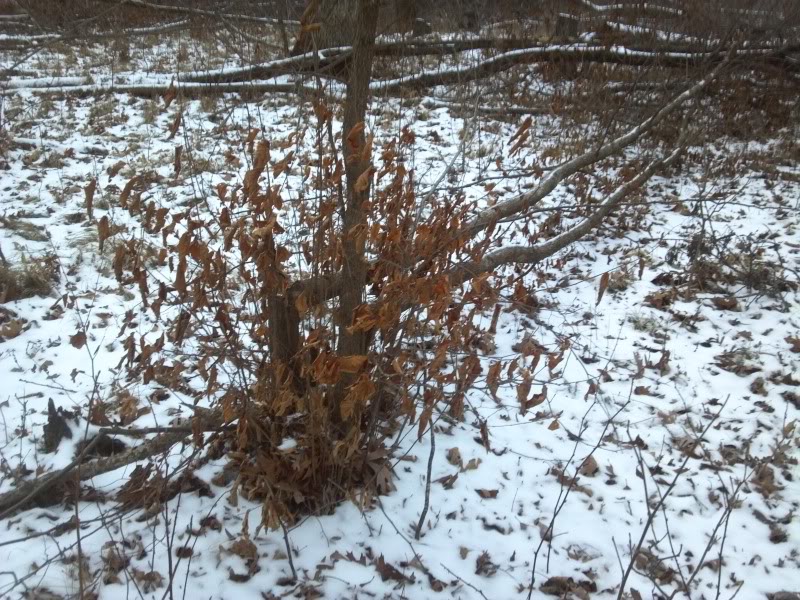
There is no mass explosion of brush from either stump nor downed tree
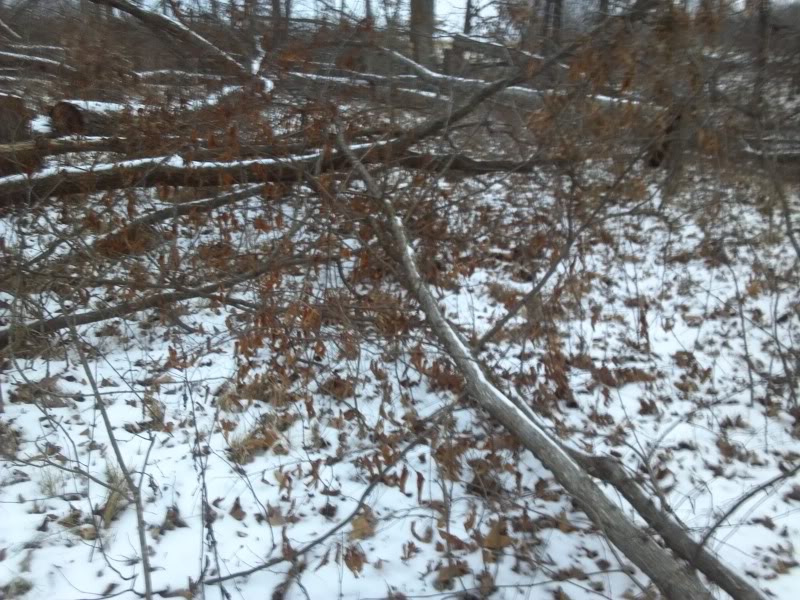
I cut them much higher so that dead or alive the provide more ground cover but still one gets an idea what to expect from this shade tolerant weed tree
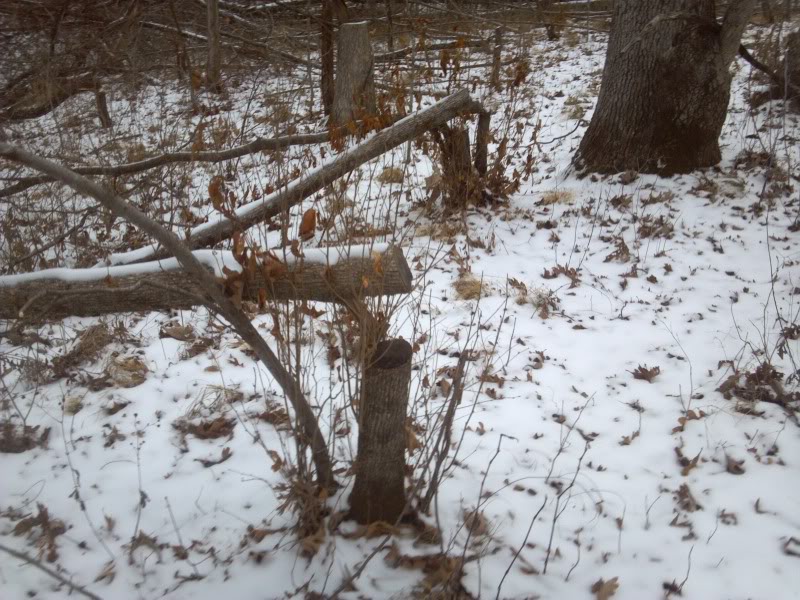
The pics of young oaks I posted previously are in the same cutting and are 3-4 times the height of the ironwood because they love sun and the ironwood does not
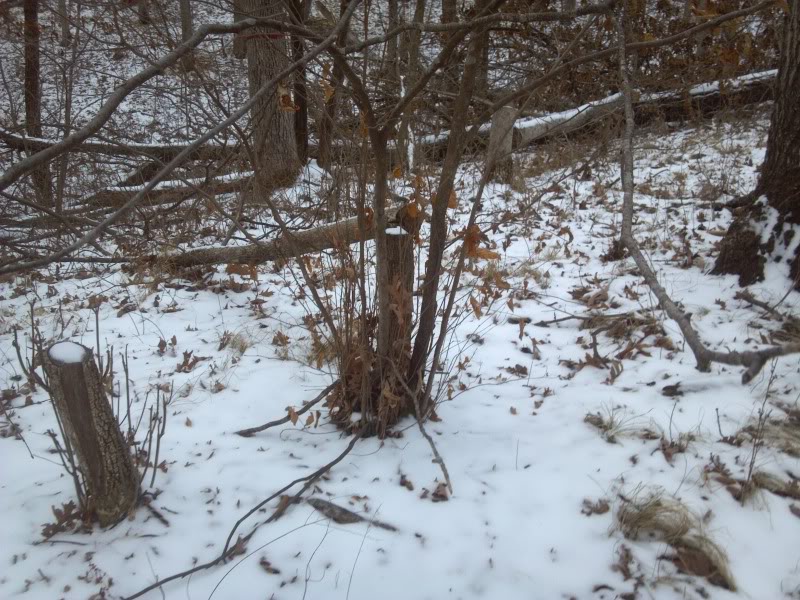
The tops of live hinged ironwood have very little leaf cover at all and are no competition at all to other growth
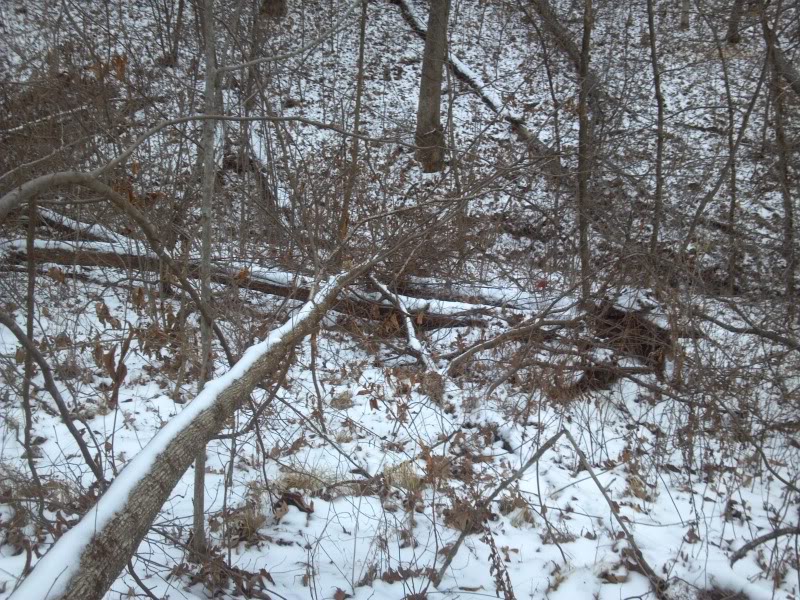
These are some recently hinged ironwood trees

They usually hinge fairly easy but respond slower when attempting to recover and re-grow so rarely create any real competition with other regeneration, such as as oaks for instance.
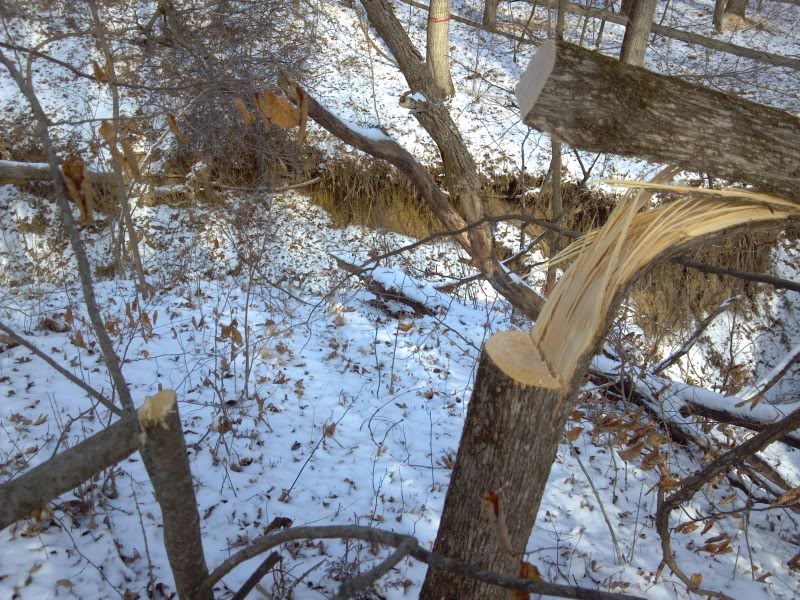
You can hinge or hinge and treat depending on your goals and concerns but I prefer to take advantage of any brush I can get when reducing canopy with hinging....
Last edited:
Crimson Arrows
Well-Known Member
Excellent post Paul. Thanks
dbltree
Super Moderator
Not quite 50 years ago now I started my first habitat projects by building brush piles for small game and I soon learned that a pile of brush was an open invitation for song birds to roost in the relative safety of the piled branches. They of course left behind droppings filled with seeds of every imaginable kind of plant which soon turned the whole thing into a "living brushpile" so to speak.
That same thing occurs when we hinge trees or even merely drop them and is one of the ways the newly opened area soon becomes filled with new cover. On a recent consultation the landowner and I ran into a situation where the same phenomenon had occurred with red cedars....birds roosting in small hedge trees left droppings filed with red cedar seeds after having consumed the berries.
Not the greatest pics because I had my cell phone but you get the idea...under each tree there had sprang up a mass of little red cedars!

This is noteworthy on several counts because red cedars are great bedding/screening cover and I am often asked...will they grow within the hinged areas and the answer is absolutely yes (red cedars don't do well on wet low soils however) Hinged trees rarely have any canopy at all (compared to erect trees) but the little cedars can obviously stand some shade.
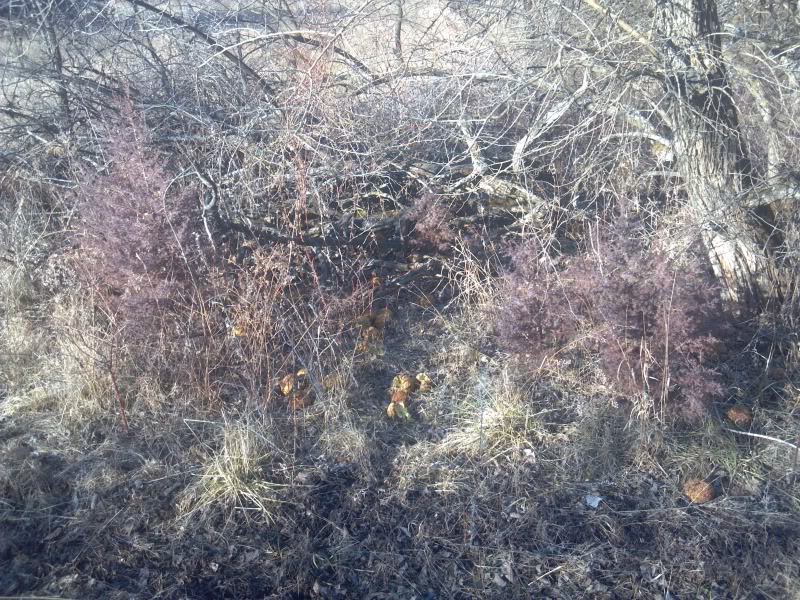
In all of my hinged areas I have natural regeneration of RC's but lacking seed trees in the area one can certainly plant them among the downed tops and expect them to do quite well.
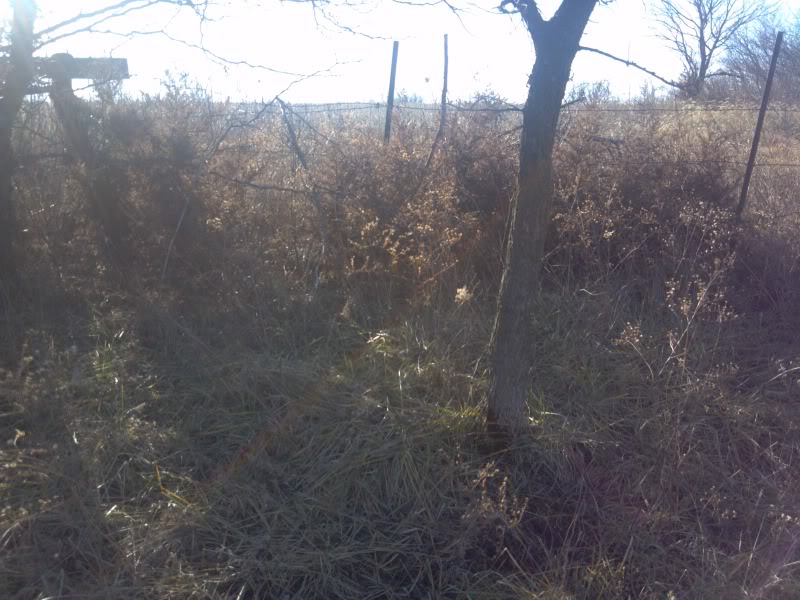
Other conifers such as white or Norway spruce may also do well inter-planted into hinged areas and while white pines would also do well they do not make good cover long term and are very vulnerable to browsing/rubbing.
Hinging weed/cull trees helps being about a chain reaction of habitat changes and with a little help we can make it even better by adding some conifers in at least some areas of the hinge cuttings....
That same thing occurs when we hinge trees or even merely drop them and is one of the ways the newly opened area soon becomes filled with new cover. On a recent consultation the landowner and I ran into a situation where the same phenomenon had occurred with red cedars....birds roosting in small hedge trees left droppings filed with red cedar seeds after having consumed the berries.
Not the greatest pics because I had my cell phone but you get the idea...under each tree there had sprang up a mass of little red cedars!

This is noteworthy on several counts because red cedars are great bedding/screening cover and I am often asked...will they grow within the hinged areas and the answer is absolutely yes (red cedars don't do well on wet low soils however) Hinged trees rarely have any canopy at all (compared to erect trees) but the little cedars can obviously stand some shade.

In all of my hinged areas I have natural regeneration of RC's but lacking seed trees in the area one can certainly plant them among the downed tops and expect them to do quite well.

Other conifers such as white or Norway spruce may also do well inter-planted into hinged areas and while white pines would also do well they do not make good cover long term and are very vulnerable to browsing/rubbing.
Hinging weed/cull trees helps being about a chain reaction of habitat changes and with a little help we can make it even better by adding some conifers in at least some areas of the hinge cuttings....
dbltree
Super Moderator
Unexpected dangers
Working in the timber is dangerous from the time you fire up the saw til you shut it down for the day. There are the obvious dangers when falling trees, they can snap backwards, fly up in the air 20 feet and slam to the ground, or flip and roll....all in the blink of an eye! There is no such thing as "safe" ways to fall trees because even the simple act of girdling a tree can bring it crashing to the earth if...it's rotten inside!!
I have had too many near misses when I didn't even want to fall the tree!
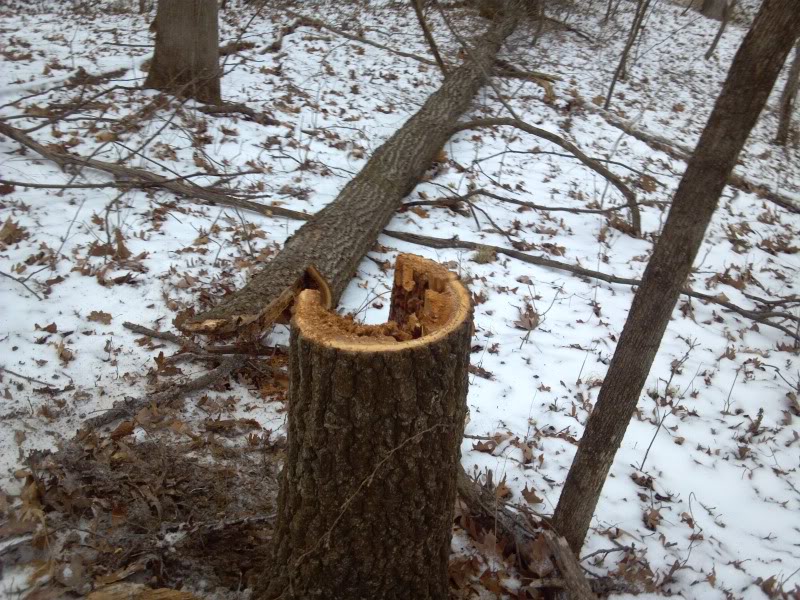
Be alert and aware, especially when you are not planning on the tree falling. Another frequent danger is dead limbs that snap off and ricochet thru the air, often larger then a fence post! This one landed inches in front of me and nearly broke my hand as it slammed into me...
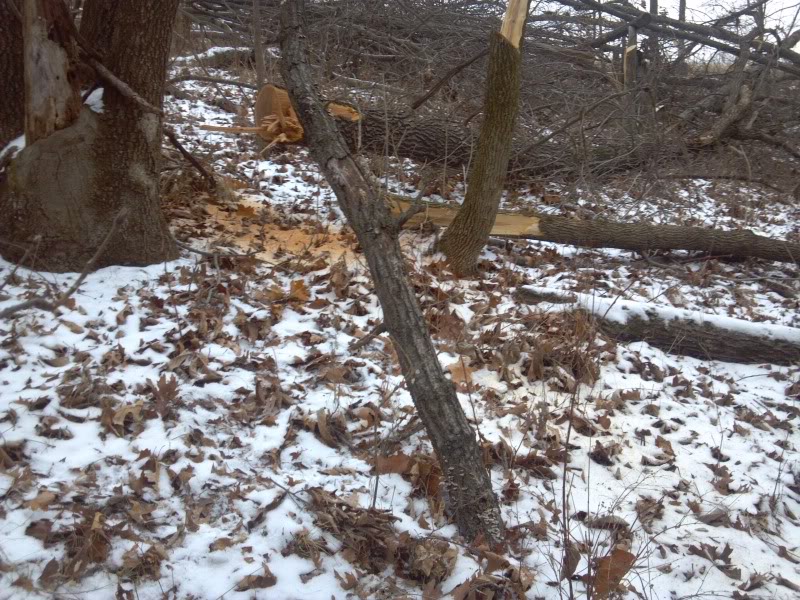
Keep in mind I do this for a living and 6 days a week all winter so I see things that one may not when only doing a weekends work, but the potential is always there for one to get severely hurt or worse. Where hard hat and chainsaw chaps and never ever let your guard down!
Beds
Working in the timber every day from late November til April 1st allows me to learn a lot about whitetail behavior on a lot of different properties. It's always interesting to note their choice of bedding and that in turn helps me focus on some areas versus others. South facing slopes always get the priority and often it takes very few downed trees to attract deer and in fact they may be less attracted to a mass of downed trees rather then a downed tree.
There also plenty that bed in the wide open
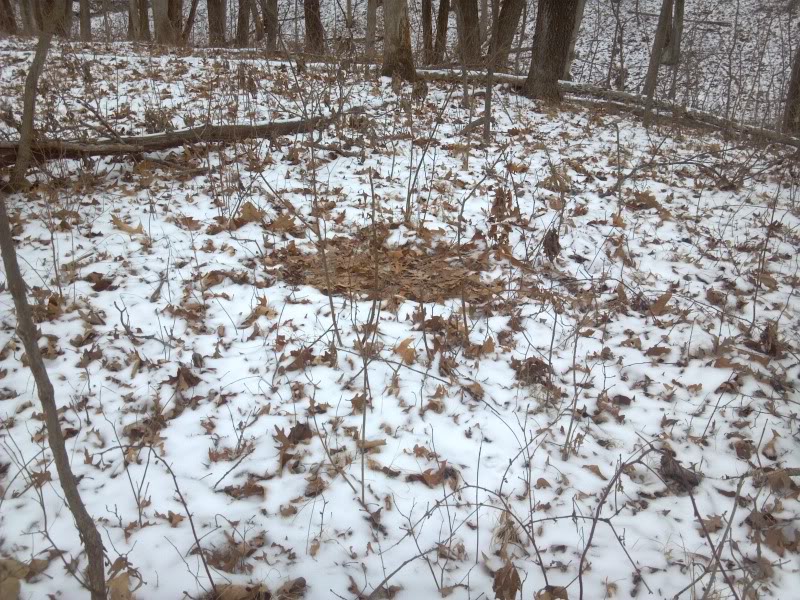
Others tucked up against a downed tree
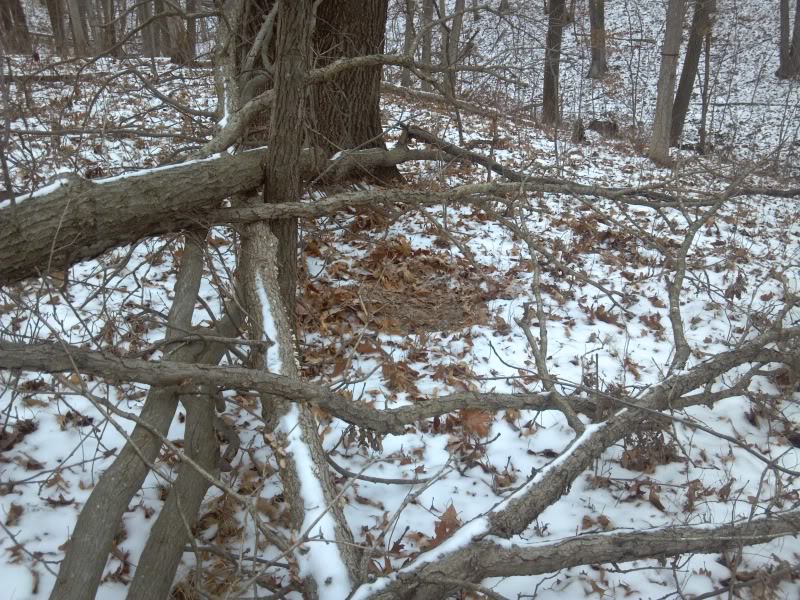
Some tucked up under a tree
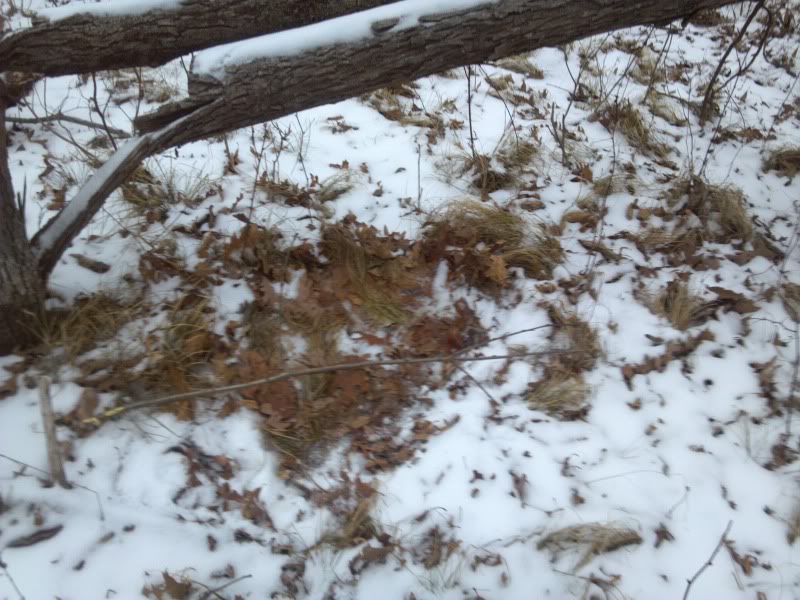
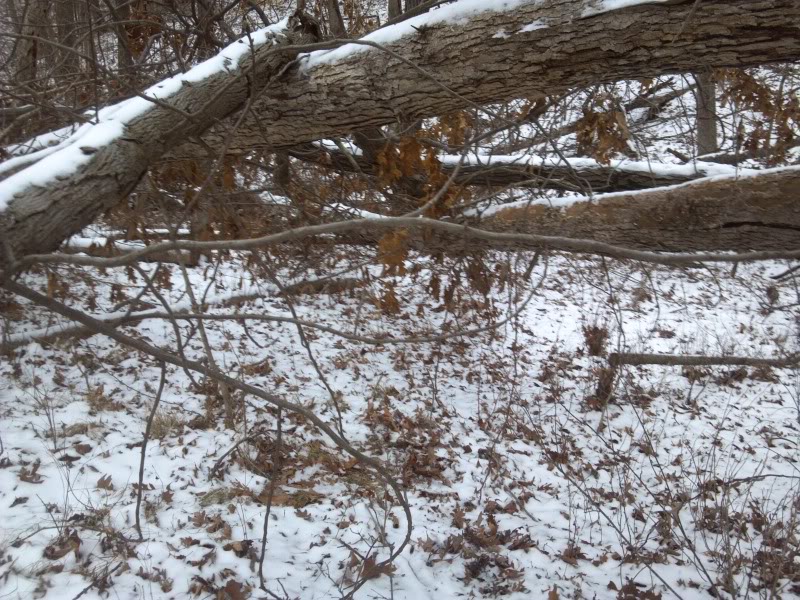
Amongst a little brush
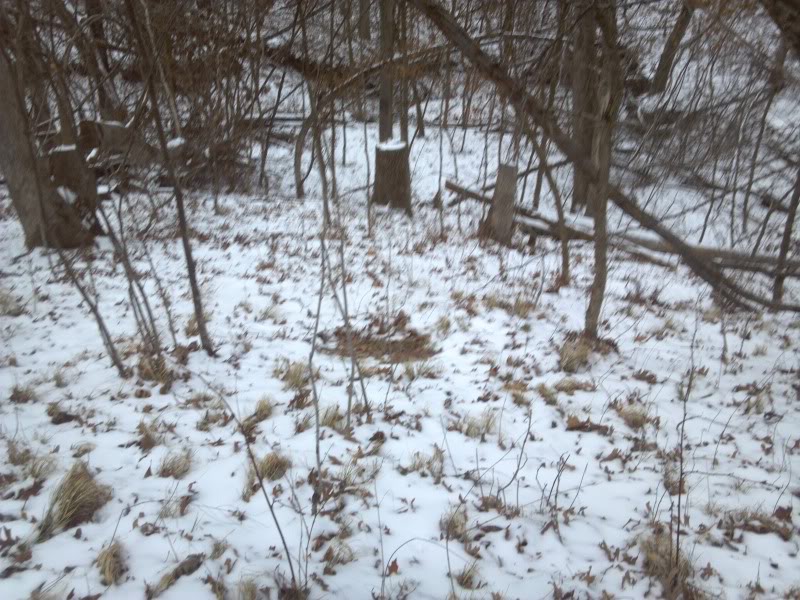
or where they can see in all directions
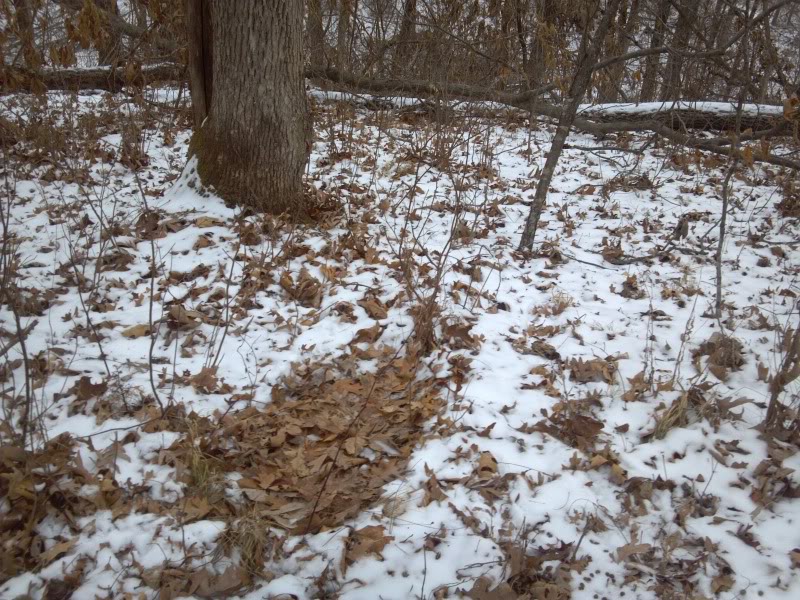
In general a mix of semi open and thick brushy areas attracts a lot of attention
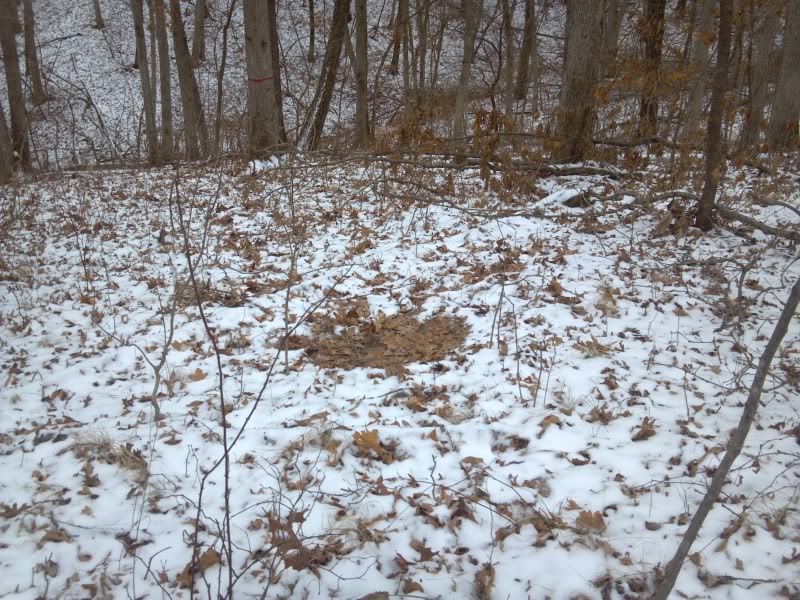
There are two places that mature timber can never compete with, a mix of brushy, grassy red cedar cover and large fields of native warm season grass but get out for a walk this winter and observe the deer bedding preferences in your area. It can be helpful as you decide how best to improve your habitat....
Working in the timber is dangerous from the time you fire up the saw til you shut it down for the day. There are the obvious dangers when falling trees, they can snap backwards, fly up in the air 20 feet and slam to the ground, or flip and roll....all in the blink of an eye! There is no such thing as "safe" ways to fall trees because even the simple act of girdling a tree can bring it crashing to the earth if...it's rotten inside!!
I have had too many near misses when I didn't even want to fall the tree!

Be alert and aware, especially when you are not planning on the tree falling. Another frequent danger is dead limbs that snap off and ricochet thru the air, often larger then a fence post! This one landed inches in front of me and nearly broke my hand as it slammed into me...

Keep in mind I do this for a living and 6 days a week all winter so I see things that one may not when only doing a weekends work, but the potential is always there for one to get severely hurt or worse. Where hard hat and chainsaw chaps and never ever let your guard down!
Beds
Working in the timber every day from late November til April 1st allows me to learn a lot about whitetail behavior on a lot of different properties. It's always interesting to note their choice of bedding and that in turn helps me focus on some areas versus others. South facing slopes always get the priority and often it takes very few downed trees to attract deer and in fact they may be less attracted to a mass of downed trees rather then a downed tree.
There also plenty that bed in the wide open

Others tucked up against a downed tree

Some tucked up under a tree


Amongst a little brush

or where they can see in all directions

In general a mix of semi open and thick brushy areas attracts a lot of attention

There are two places that mature timber can never compete with, a mix of brushy, grassy red cedar cover and large fields of native warm season grass but get out for a walk this winter and observe the deer bedding preferences in your area. It can be helpful as you decide how best to improve your habitat....
dbltree
Super Moderator
Re-growth after hinging
The following pictures are from an area I hinged over 4 years ago and while different soils and trees species will produce different results, it gives on an idea what to expect when radical hinging/opening up of canopy is done.
Notice the regrowth on this downed tree, all of it providing ready browse and cover
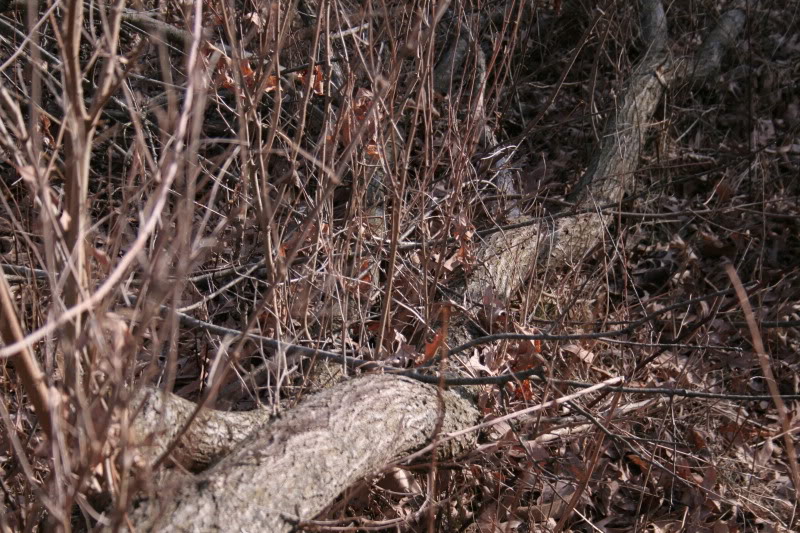
Shingle oaks don't often stay hinged because they are quite brittle but this one is leafed out end to end, yet has no canopy to interfere with oak regeneration.
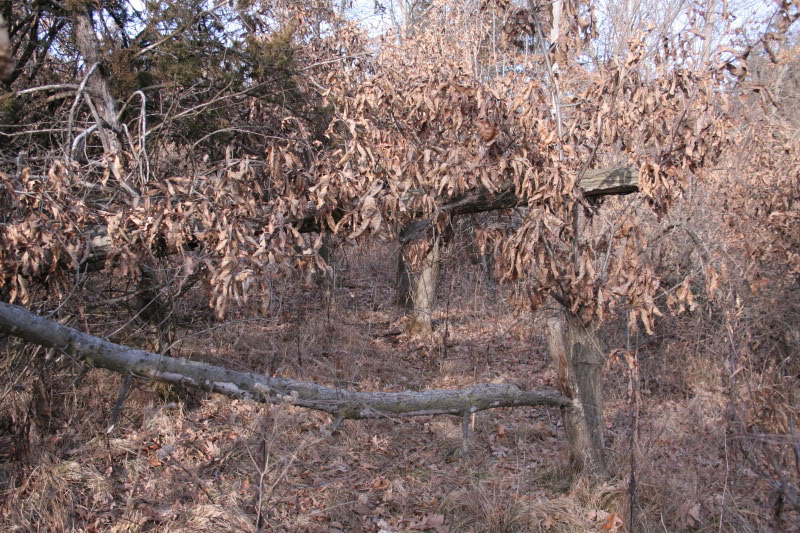
Other trees may not send up much growth along the stem but will from the cut stump
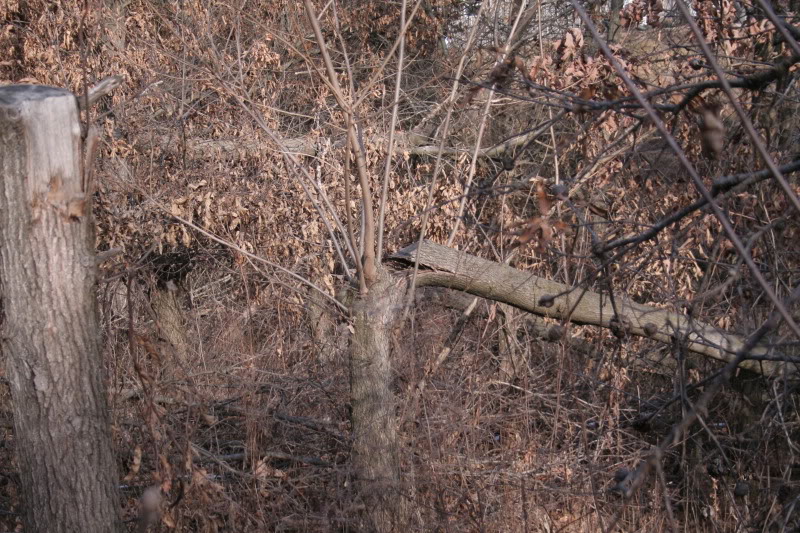
Several examples of cut stumps that have exploded with new growth

so while cutting the tree high enough and keeping it hinged is very helpful in providing immediate cover

It's certainly not imperative and nothing to worry about if some trees break off

Deer scat and beds are everywhere

Thanks to copious amounts of easy to reach browse
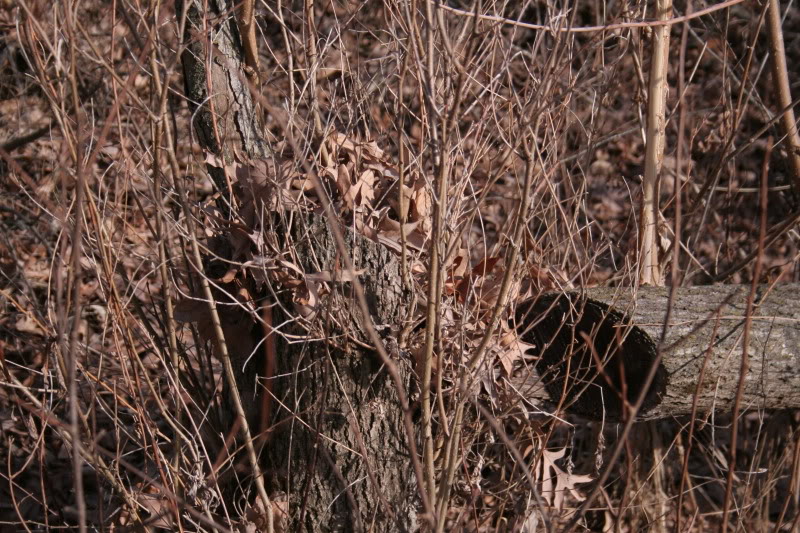
and the thick cover where it was once wide open

Deer live comfortably in this area even though it is a stones throw from my house
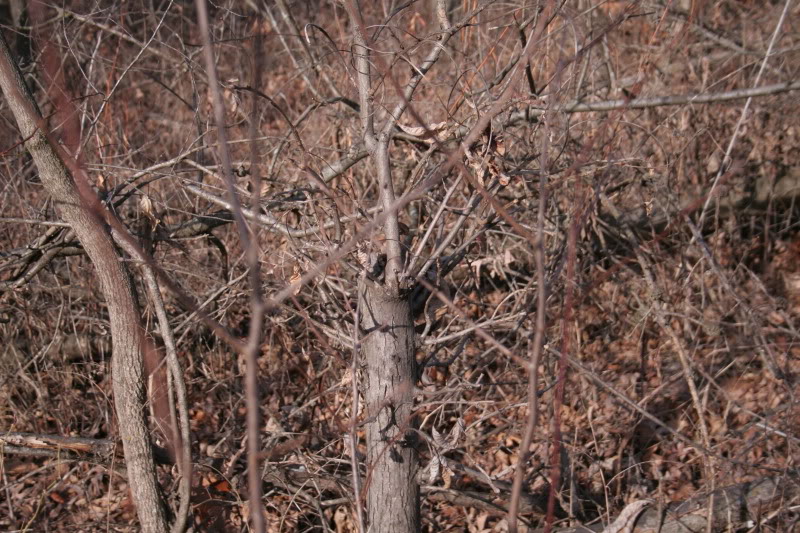
I have a funnel thru this mass of brush and brambles

and have killed two beautiful bucks that prefer the "highway" over stumbling around in the nasty mess when their only goal is finding a hot doe
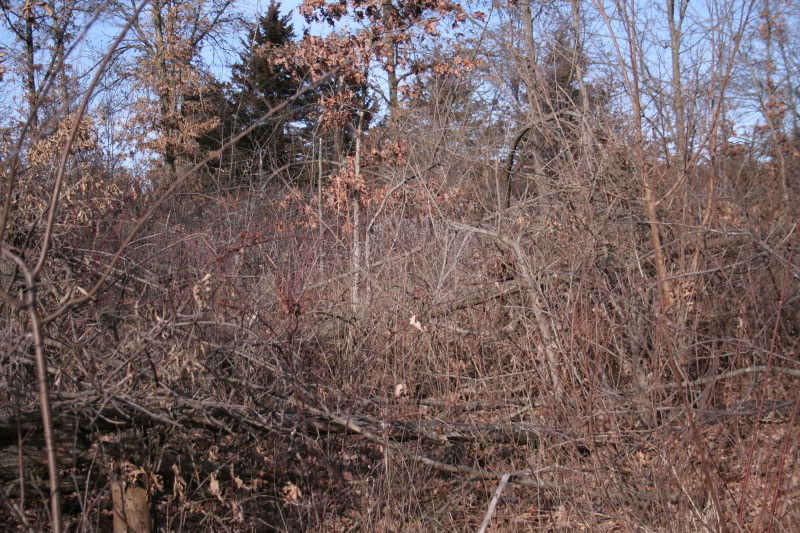
Scattered small openings such as under this red cedar each have one or more beds
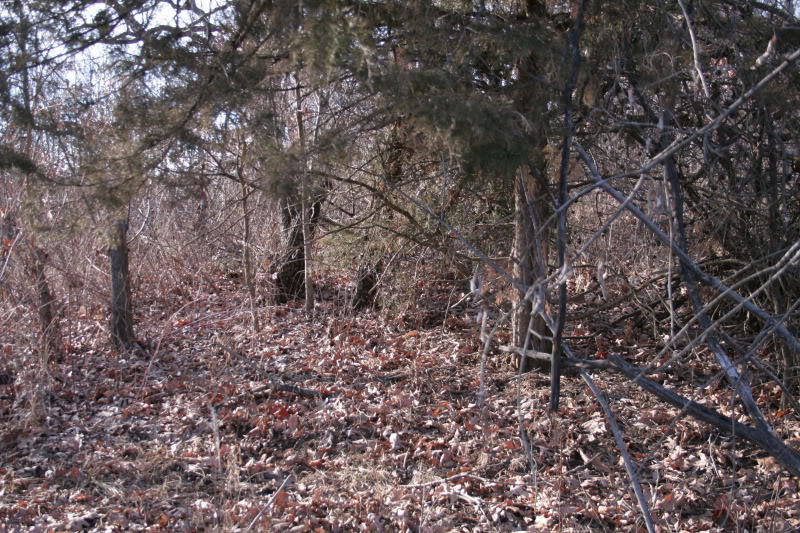
You can see the bed under this little cove of brush (the flag is a hybrid oak planted after hinging)
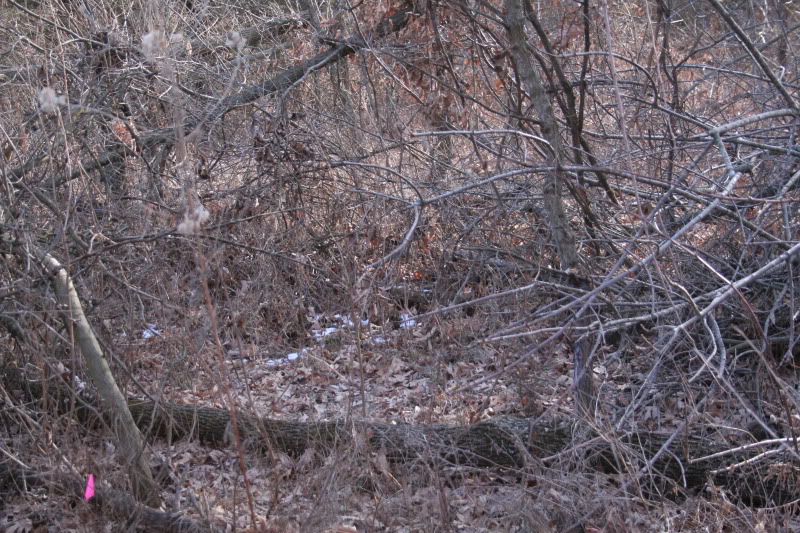
They have runways thru/under the hinged trees...if you look carefully at the top left you can see our driveway!
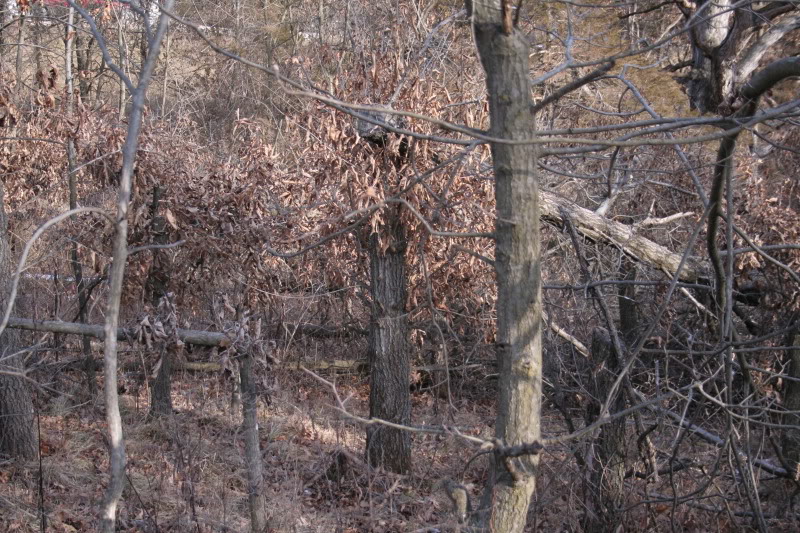
With this kind of thick cover however, whitetails are comfortable and find all their needs met.
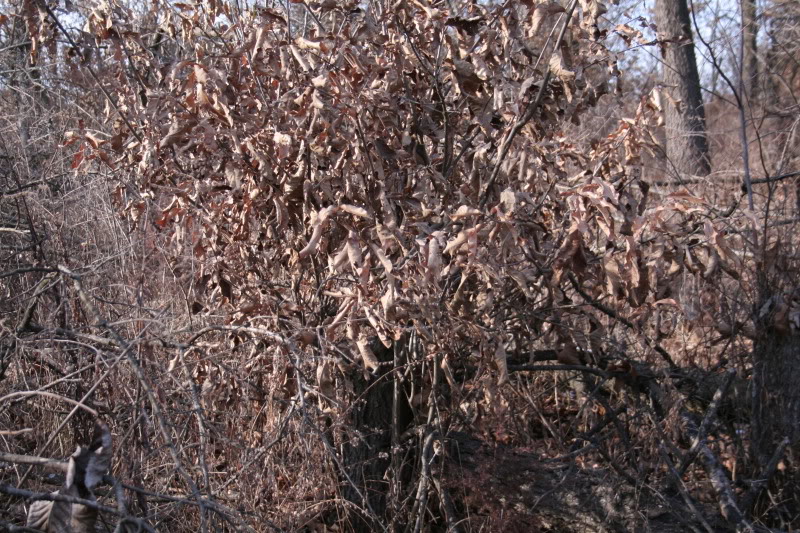
All of my cover leads to one central feeding area, so all doe groups travel back and forth daily to that single feeding area. Because I have created funnels and blocked off multiple runways by utilizing edge feathering, bucks beat those "rut runways" to death during the rut. Those funnels are in the interior of the timber utilizing any natural bottlenecks and hinged trees to create the funnel. Hunting these funnels has allowed me to be consistently successful harvesting the most mature whitetail bucks on my property.
Provide year around cover and food and then use the most effective hunting techniques and you will consistently harvest the best deer on your property....
The following pictures are from an area I hinged over 4 years ago and while different soils and trees species will produce different results, it gives on an idea what to expect when radical hinging/opening up of canopy is done.
Notice the regrowth on this downed tree, all of it providing ready browse and cover

Shingle oaks don't often stay hinged because they are quite brittle but this one is leafed out end to end, yet has no canopy to interfere with oak regeneration.

Other trees may not send up much growth along the stem but will from the cut stump

Several examples of cut stumps that have exploded with new growth

so while cutting the tree high enough and keeping it hinged is very helpful in providing immediate cover

It's certainly not imperative and nothing to worry about if some trees break off

Deer scat and beds are everywhere

Thanks to copious amounts of easy to reach browse

and the thick cover where it was once wide open

Deer live comfortably in this area even though it is a stones throw from my house

I have a funnel thru this mass of brush and brambles

and have killed two beautiful bucks that prefer the "highway" over stumbling around in the nasty mess when their only goal is finding a hot doe

Scattered small openings such as under this red cedar each have one or more beds

You can see the bed under this little cove of brush (the flag is a hybrid oak planted after hinging)

They have runways thru/under the hinged trees...if you look carefully at the top left you can see our driveway!

With this kind of thick cover however, whitetails are comfortable and find all their needs met.

All of my cover leads to one central feeding area, so all doe groups travel back and forth daily to that single feeding area. Because I have created funnels and blocked off multiple runways by utilizing edge feathering, bucks beat those "rut runways" to death during the rut. Those funnels are in the interior of the timber utilizing any natural bottlenecks and hinged trees to create the funnel. Hunting these funnels has allowed me to be consistently successful harvesting the most mature whitetail bucks on my property.
Provide year around cover and food and then use the most effective hunting techniques and you will consistently harvest the best deer on your property....
IQDM
New Member
A few weeks ago I stumbled across a thread and a guy was talking about hinge cutting aspen... I can tell you from first hand experience that hinging that type of trees does not work!
These are poplar I believe, but poplar, birch, aspen... same type of tree
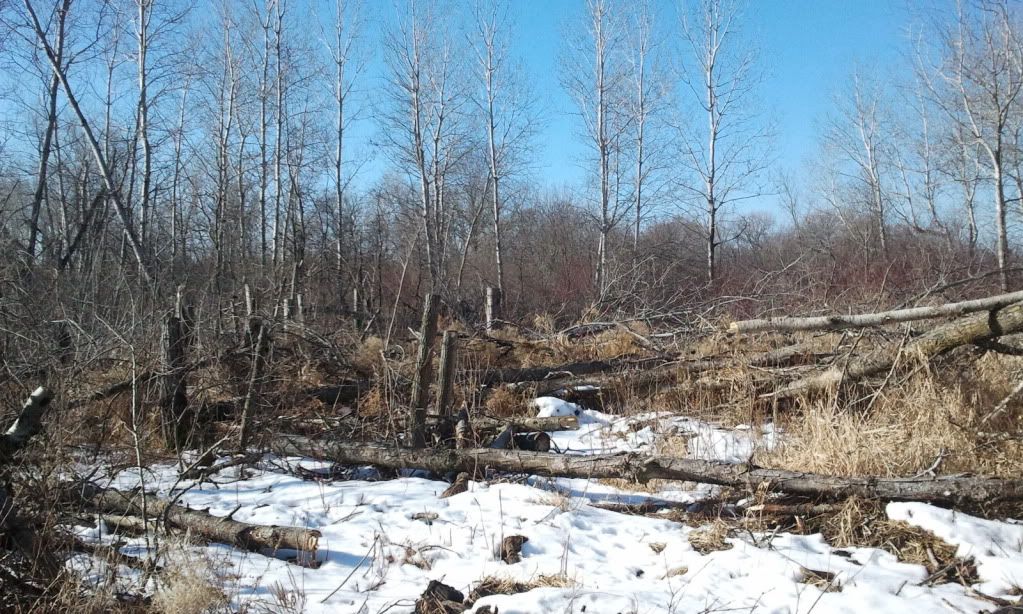
I have a lot of these trees on my property and when I first learned of hinge cutting, I gave it a shot. As you can see, I created a mess, but the trees did not survive.
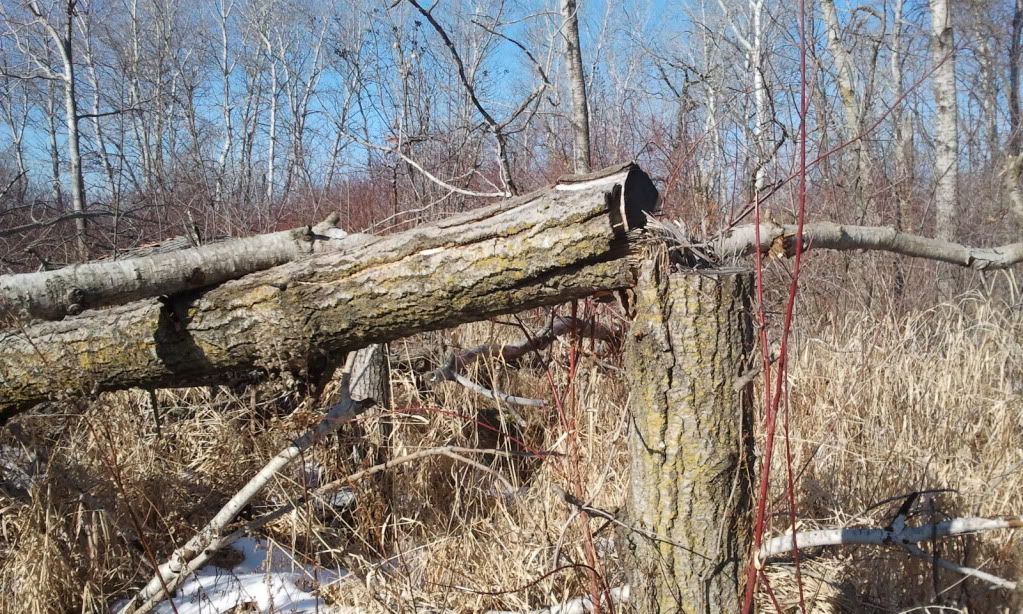
Many of them have broken off and only left a stump remaining.
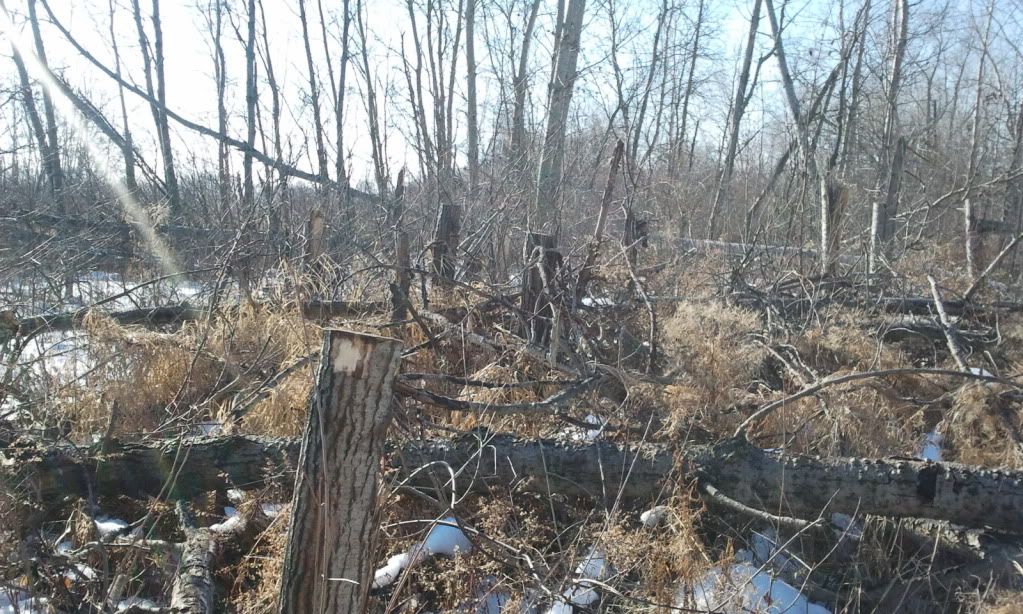
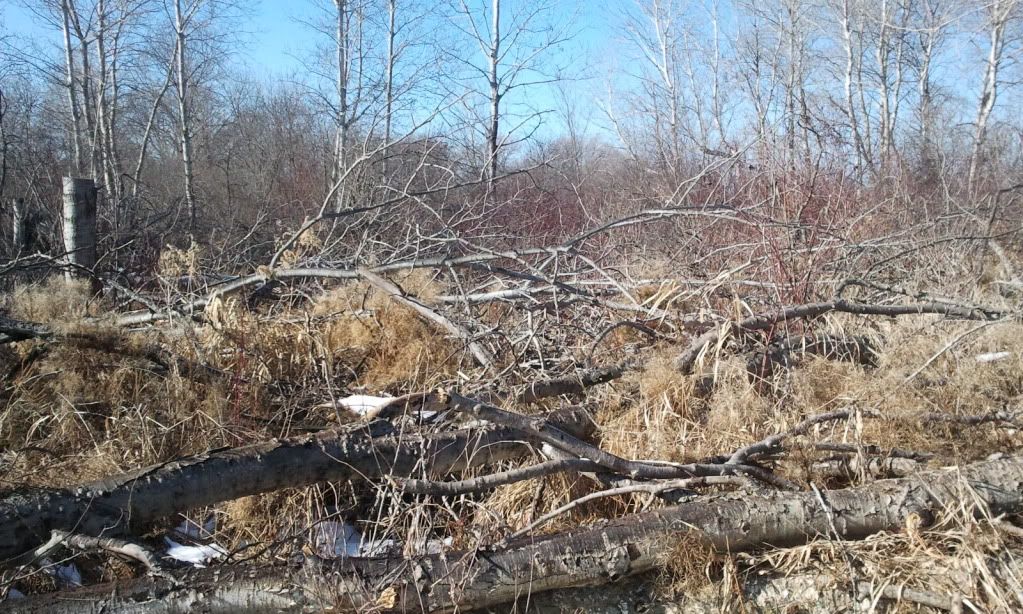
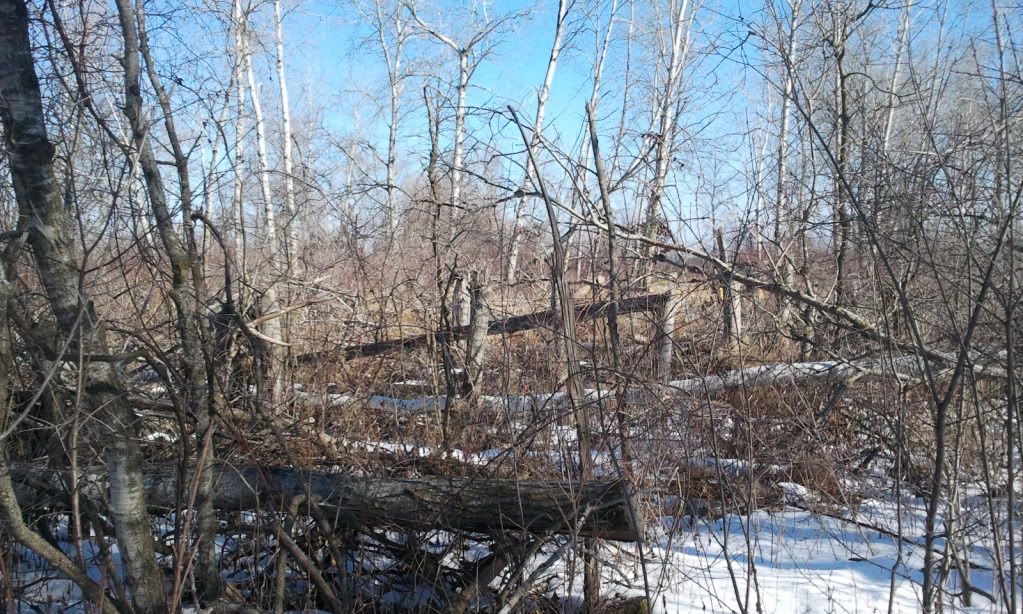
The deer do not go into this area because the trees are laying across eachother in every direction. So the mess needs to go! I will just let it re-generate and in no time it will be thick bedding!
We took all of the dead trees and piled them up along the edge of the "bedding area"... This is what the area looks like now
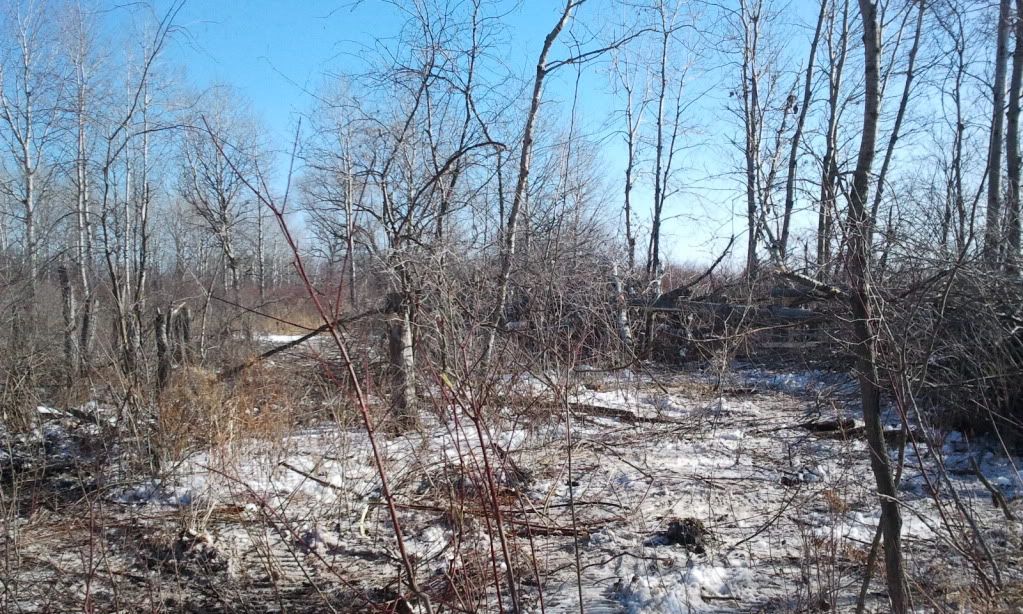
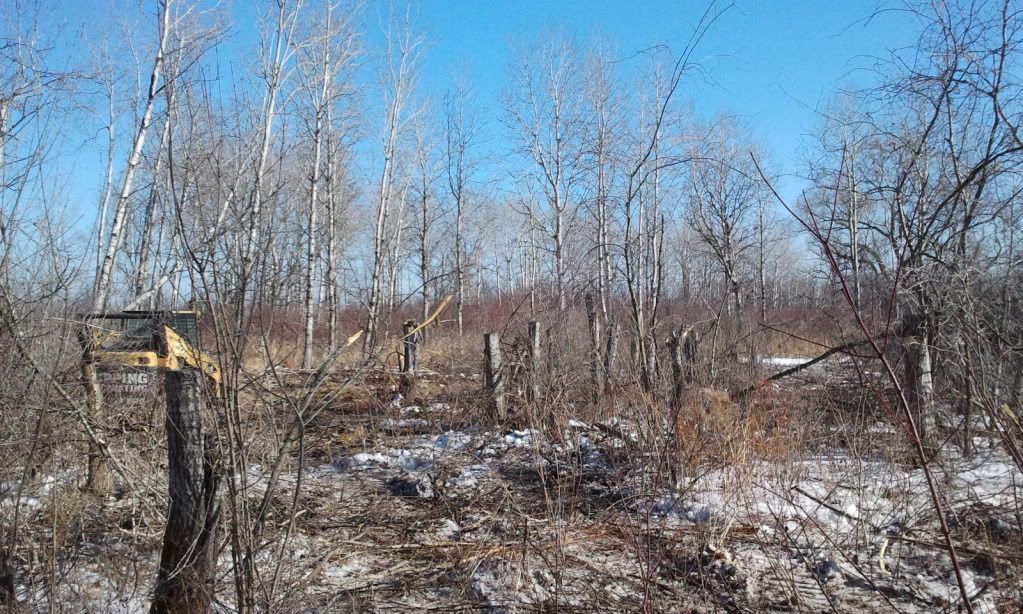

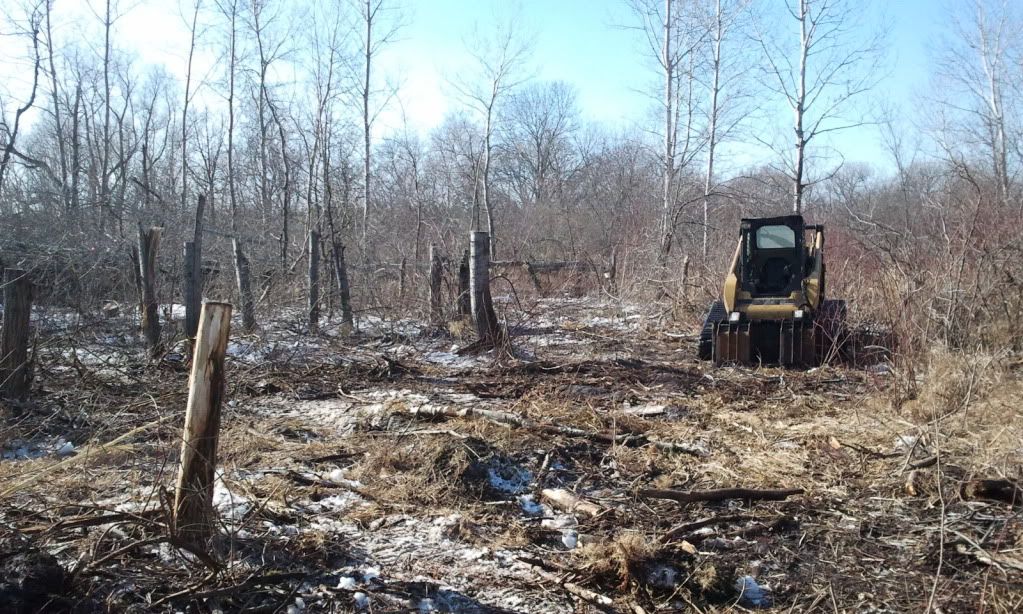
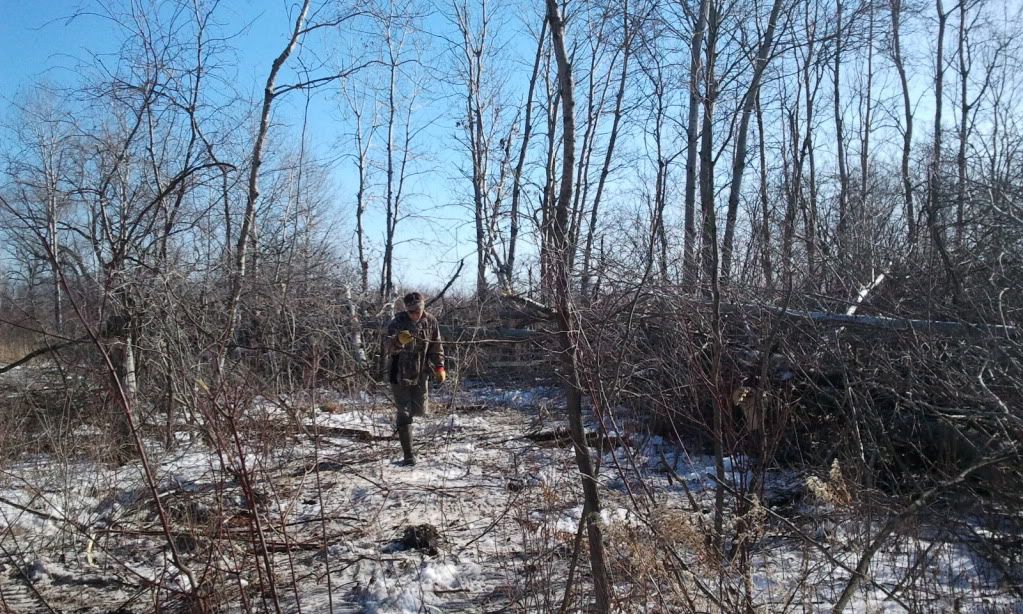
Our next project for the day was to block field entrances along this tree line.

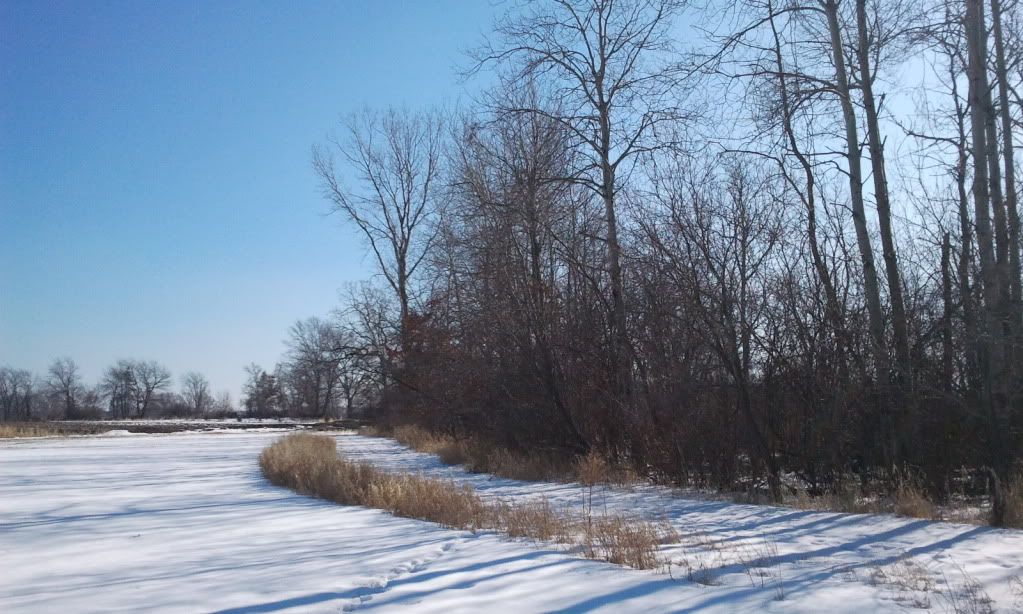

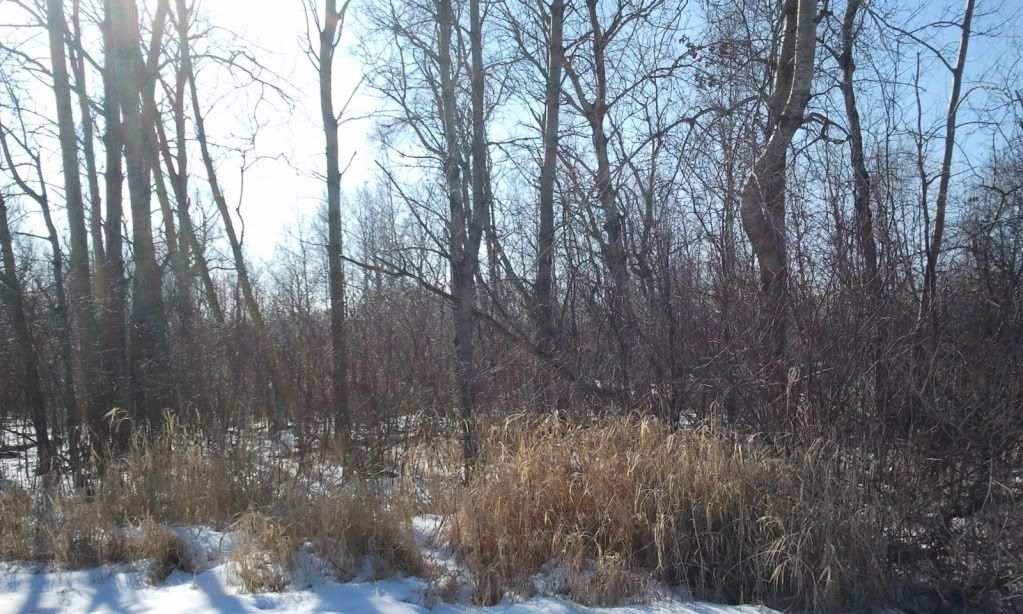
One hour later...

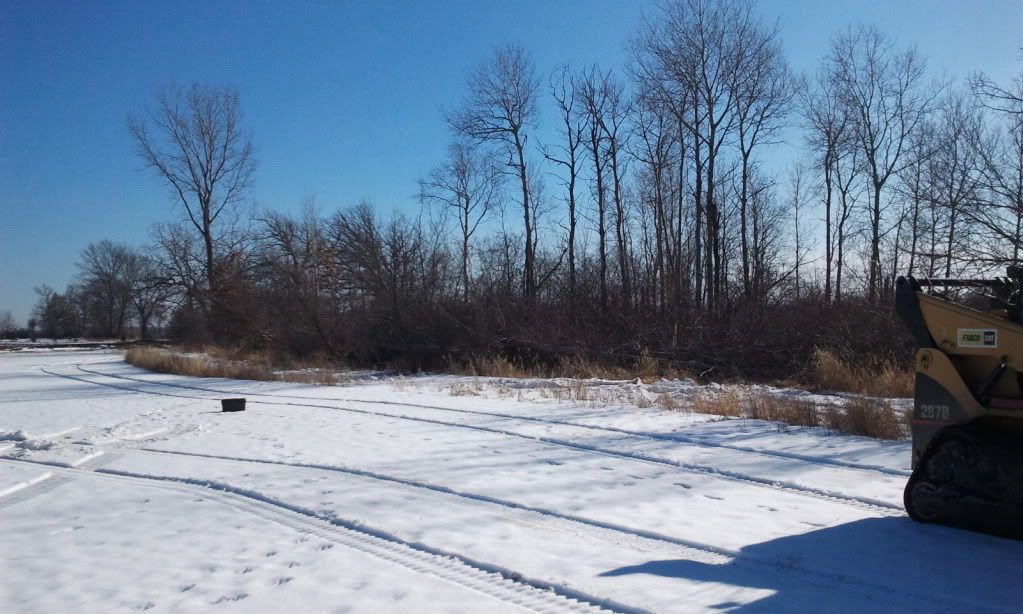
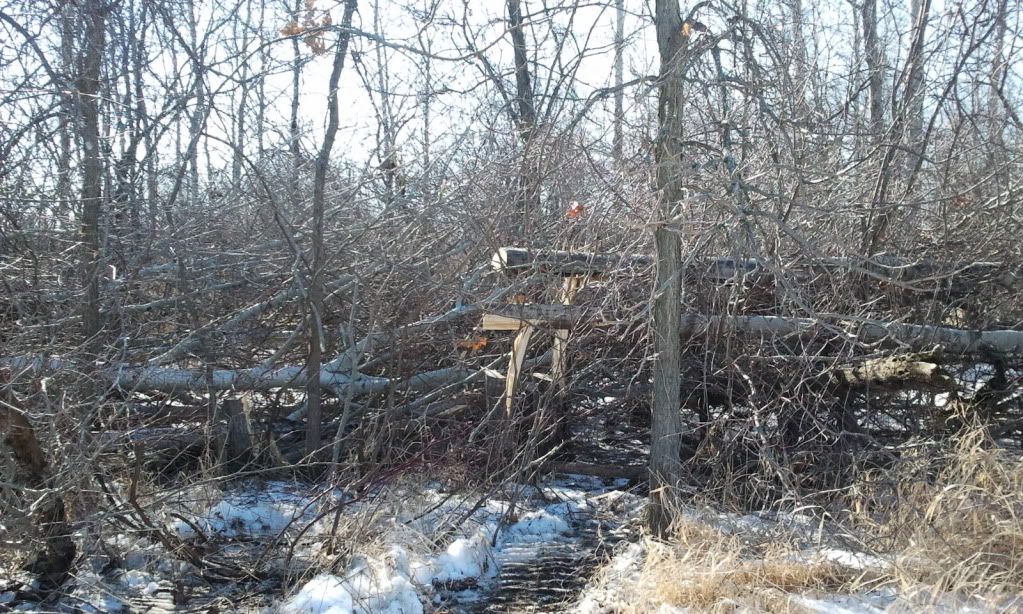
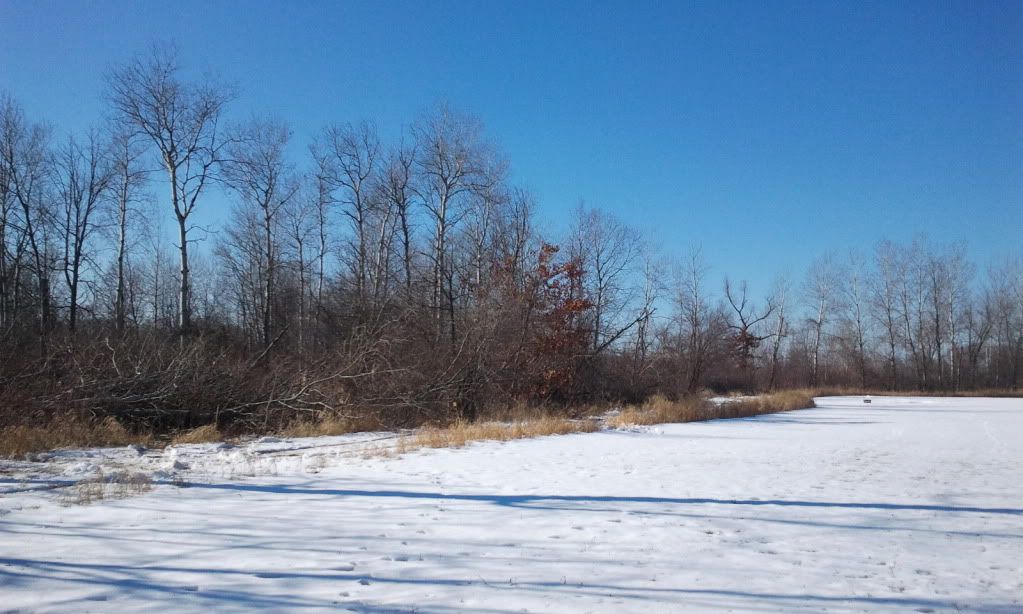
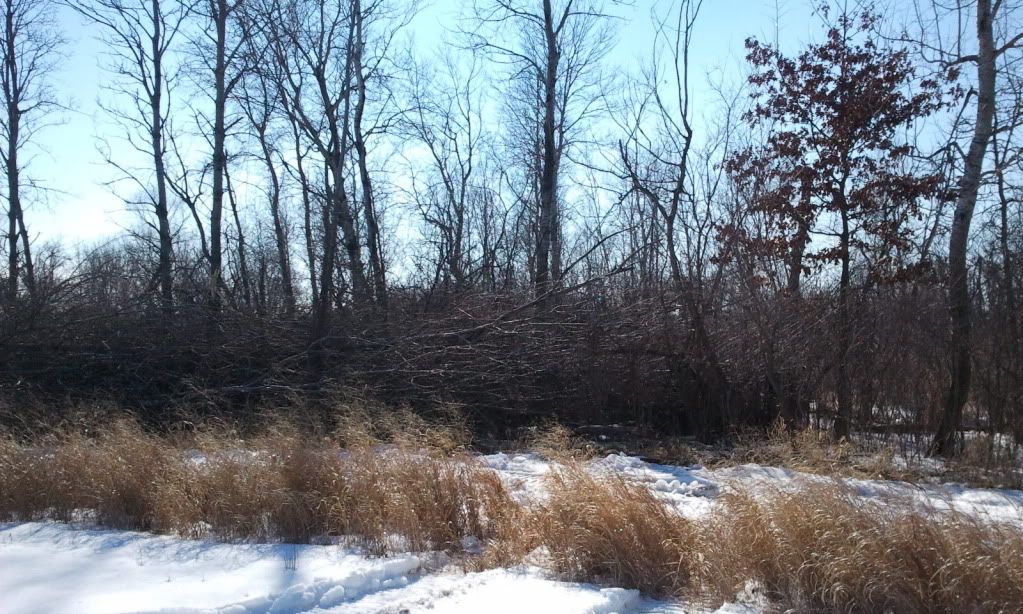
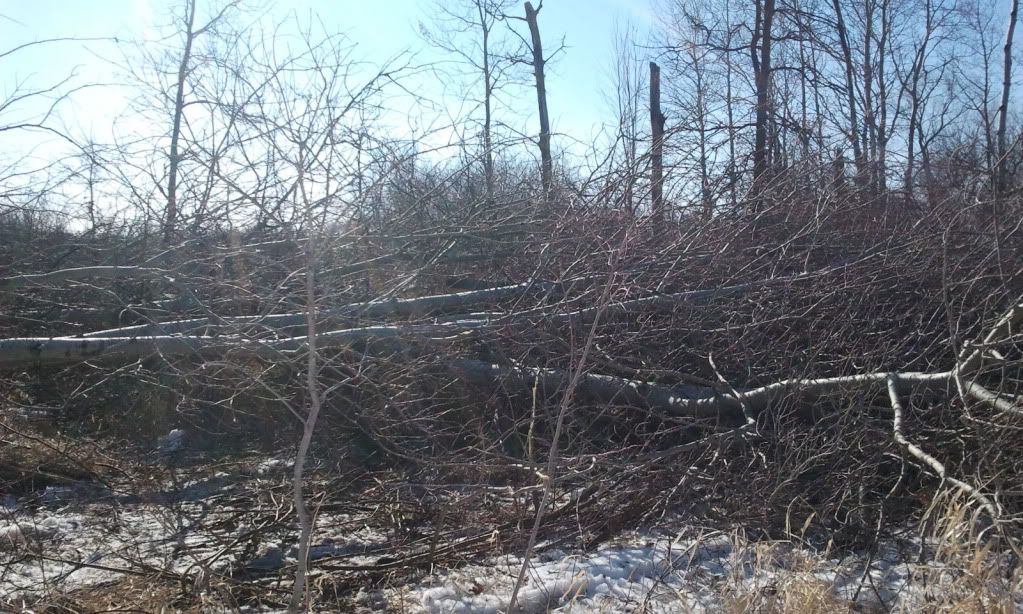
Now the deer will be forced to funnel around this mess and will travel within chip shot range of our bow stands on each end!
These are poplar I believe, but poplar, birch, aspen... same type of tree

I have a lot of these trees on my property and when I first learned of hinge cutting, I gave it a shot. As you can see, I created a mess, but the trees did not survive.

Many of them have broken off and only left a stump remaining.



The deer do not go into this area because the trees are laying across eachother in every direction. So the mess needs to go! I will just let it re-generate and in no time it will be thick bedding!
We took all of the dead trees and piled them up along the edge of the "bedding area"... This is what the area looks like now





Our next project for the day was to block field entrances along this tree line.




One hour later...






Now the deer will be forced to funnel around this mess and will travel within chip shot range of our bow stands on each end!
dbltree
Super Moderator
hinge cutting aspen... I can tell you from first hand experience that hinging that type of trees does not work!
Your right...better to just clear cut or at least just cut them off for fast re-growth, although leaving some hinged for some ground cover wouldn't hurt even though they won't live.
Nice work on the funnels and thanks for sharing the pics! :way:
Hinging Hickory
Lot's of hickory species and depending on where you live you'll probably find some in your timber
Here's a link for help in identifying the various hickory types
Identify Hickory - The Major Hickory Species in North America
For the most part, hickories are lower in value then walnuts and oaks and they have little value to whitetails, unless....we tip them over. Here's a stand of shagbark hickories before

and after I tipped them over...this one is actually a bitternut hickory
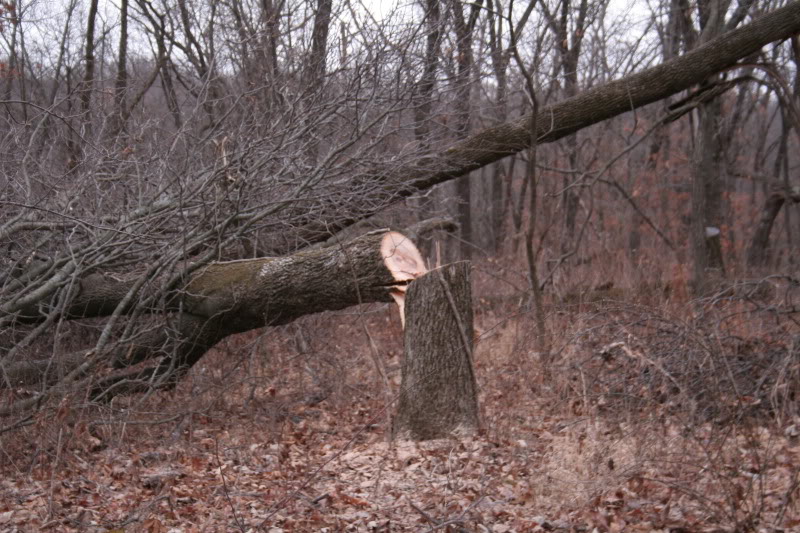
Large and small they usually hinge pretty well and a large percentage stay alive although they seldom send up a great deal of re-growth.
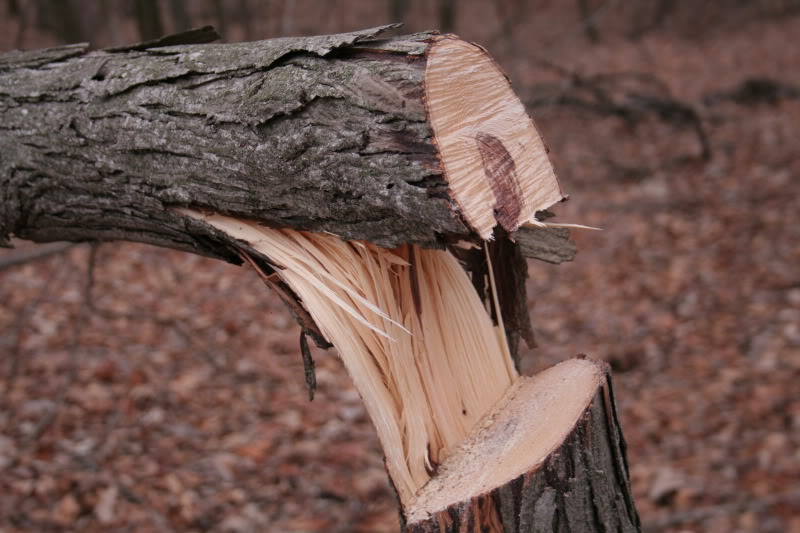
Still....it allows us to create instant ground cover
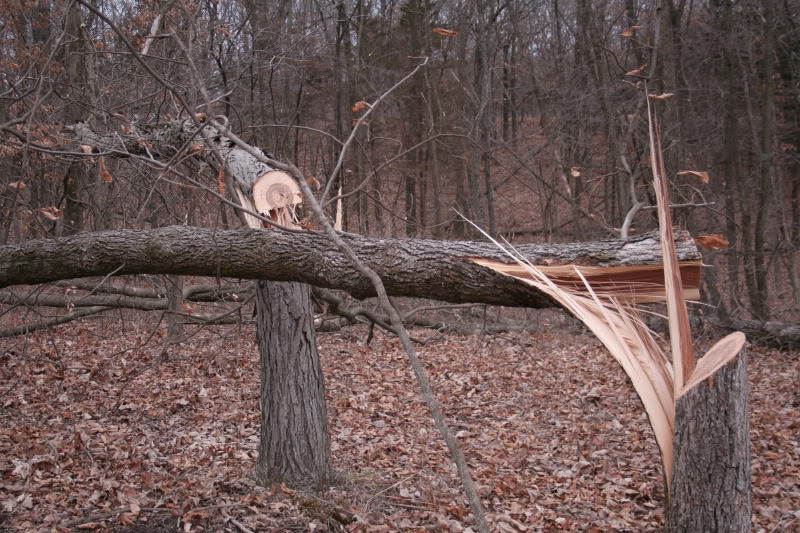
and the newly opened canopy will soon come alive with all types of undergrowth
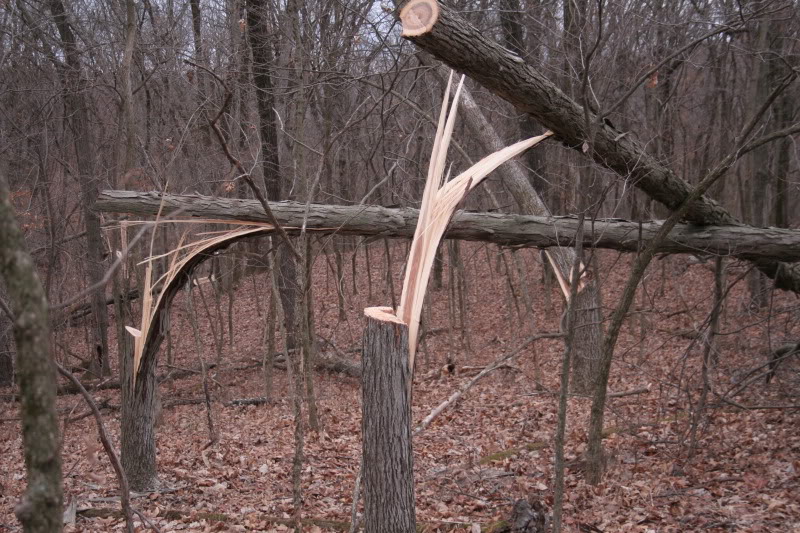
When there are many trees, a large tree may fall and break off other smaller trees previously hinged, those stumps will send up new growth and the combination will still provide cover and browse.
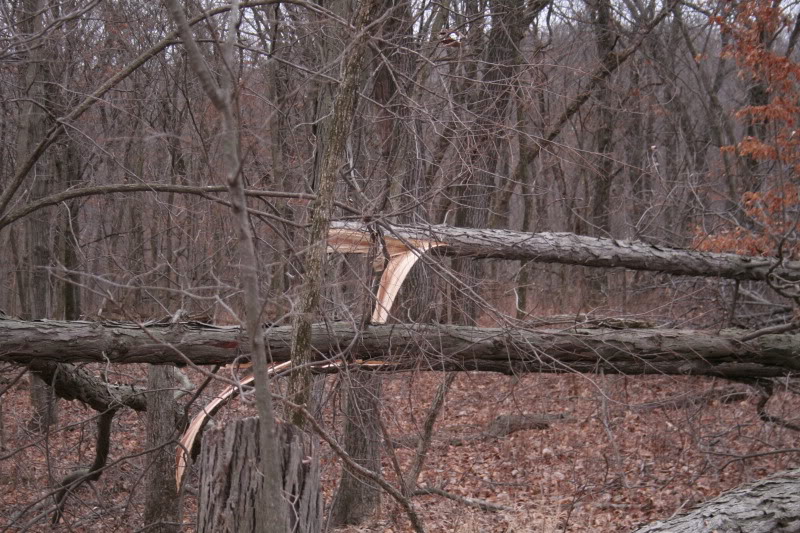
Hickories take years to decompose if the die after being cut so they continue to provide cover while new growth comes up thru the downed tops. Standing however they provide such a dense canopy that almost nothing can grow leaving an empty wasteland of open understory that will be nearly void of whitetails.
If you have more then 50 mature hickories you may be able to market those first but otherwise use a combination of girdling and hinging to release any oak trees and allow sunlight to create a new dense understory that will in turn become a haven for whitetails....